FOREWORD
THEATER is by its very nature an ephemeral
art. As a musical score requires performers for its realization,
so a theatrical script requires the energies of many
artists – actors and directors, scenic and costume
designers, carpenters, painters, and tailors – to
create the illusion of a life beyond the reality of the
audience. That illusion ends with the final curtain,
when the dramatis personae remove their masks and take
their bows, revealing themselves as the actors they are.
Going backstage and viewing the sets up close, discovering
the carpentered trusses that support the facades of painted
castles or dungeons, gardens or forests, we may experience
a similar disillusion. But just as we admire the art
of the actor, the professional's ability to become an
other, so too we admire the art of the scenographer,
the craft that must necessarily support the imagination
if we are to believe in that other, staged world.
Joseph Urban was a designer and builder of such alternative
worlds, for the opera stages of Boston and New York and for the Ziegfeld
Follies. Columbia is the fortunate repository of the archives that
document this very active theatrical imagination. The many hundred models,
watercolors, drawings, and plans that constitute the Joseph Urban Collection
permit a more direct access to an era of American stage life than any
photo graphic record might. In these works we encounter the poetic projections
of an architectural imagination, setting the stage for that "heightened
sense of life" that Urban felt was the essential theatrical experience.
As the models and watercolors in this
exhibition demonstrate, Urban's was a world of color. Architect
of Dreams: The Theatrical Vision of Joseph Urban offers
an occasion to reimagine that world and to appreciate
the art of a man who brought a transformative vision
to Broadway.
The exhibition also offers an opportunity
to make available to a largerpublic another important
treasure of the collections of the Columbia University
Libraries. Architect of Dreams was inspired
by the commitment of Jean Ashton, the director of the
Rare Book and Manuscript Library, to restore the glory
of the Urban archival material and was made possible
by the initial research of Gwynedd Cannan, now Curator
of the Performing Arts Collections, who was assisted
by Boni Joi Genser. The full realization of the project
depended upon the enthusiastic engagement of Arnold Aronson,
Professor of Theater Arts, who brought to the project
his own scholarship in theater history – as well
as his graduate student in the School of the Arts, Matthew
Smith, whose catalogue essay addresses Urban's contribution
to American film design.
Like every exhibition in the Miriam
and Ira D. Wallach Gallery, Architect of Dreams and
its accompanying catalogue became reality through the
efforts of Sarah Elliston Weiner, the director of the
gallery, and her staff: Jeanette Silverthorne, assistant
director; Brooke Sperry, administrative assistant; and
the essential Lawrence Soucy, technical coordinator.
The support of the Austrian Cultural
Institute, New York, for this project is gratefully acknowledged.
For her particular interest and assistance, I want to
express a special note of gratitude to Dr. Lee MacCormick
Edwards, the chair of the Wallach Art Gallery Committee
of the Advisory Council of the Department of Art History
and Archaeology. Finally, on behalf of all my colleagues,
I again thank Miriam and Ira D. Wallach, who continue
to share our enthusiasm for the enterprise that they
helped to launch.
David Rosand
Meyer Schapiro Professor of Art History
Chairman, Miriam and Ira D. Wallach Art Gallery
vii
PREFACE
COLLECTIONS relating to the development
and history of the theater have been actively gathered
at Columbia since the first decade of the twentieth century.
James Brander Matthews, who had been appointed to the
English faculty at the university in 1891 and was reportedly
the first professor of drama in the United States, encouraged
his students to involve themselves directly in the life
of the stage. A successful playwright himself who would
become a widely published critic, Matthews believed that
the artifacts of theatrical history had a lively role
to play in the education of budding playwrights and producers.
He searched the world tirelessly for masks, puppets,
photographs, posters, programs, and stage models to add
to the dramatic museum that he founded in 1911 to house
his growing collections. To teach Shakespeare, Renaissance
morality plays, and ancient drama, he commissioned the
creation of large plaster replicas of ancient stages;
to introduce his students to the commercial stage of
their own period, he solicited maquettes and working
models from Broadway designers. An inveterate clubman
with a wide acquaintance in the booming New York world
of popular entertainment, he successfully exploited his
social and professional connections to bring an increasingly
diverse array of new materials to the Morningside campus.
After Matthews' death in 1929, the
collections of the Dramatic Museum continued to grow,
thanks to a small endowment, but the materials added
were much more likely to be archival in nature: drawings,
papers, scenic designs, architectural renderings. Mary
Urban's gift of the complete archive of her late husband,
Joseph Urban, came to Columbia in 1958, during this later
period. The Urban papers represented at once a culmination
of Matthews' ambition to capture a sense of the working
theater in its fullest dimension and a rich addition
to the more traditional research collections of the university.
The nearly three hundred set models, bursting out of
their brown paper wrappings, still tied with ribbon marked
with the name of Urban's failed Wiener Werkstatte store
in New York, were supplemented by hundreds of letters,
drawings, photograph albums, and clipping books that
documented the artist's personal history, his life in
America, and his many careers. The collection was a scholar's
dream, promising not only new information about theatrical
design and production but a wealth of unique detail about
turn–of-the-century Viennese art and architecture,
American opera history, popular entertainment, interior
design, and the motion picture business.
Sadly, the Urban collection arrived
at time when the fortunes of the Dramatic Museum were
on the decline and modern conservation techniques were
in their infancy. All that could be done for many decades
was to see that it was safely housed and minimally accessible
to scholars who knew that it was on the campus. When
the museum was formally closed in 1971, the Urban collection
was transferred to the Columbia University Libraries
where it was stored in the stacks, still in the artist's
original containers, just as it had come from the workshop.
Librarians were happy to provide what access they could
to the papers, but the fragile condition of much of the
art work and in particular of the models, which had been
constructed from acidic paper and other ephemeral materials,
limited use. Loans to exhibitions and the publication
of a number of books referring to
ix
the collection were instrumental
in keeping Urban's accomplishments from being forgotten.
Thanks to the Gladys Krieble Delmas
Foundation and to the Preservation and Access Program
of the National Endowment for the Humanities, the story
has a happy end. Funds supplied by these agencies enabled
the Rare Book and Manuscript Library to hire a project
curator for the Joseph Urban archives, charged with the
duty of processing, rehousing, and creating a research
guide for paper collections. The approximately seven
hundred drawings and watercolors in the archives were
matted and boxed. The scrapbooks were microfilmed, and
critical conservation work completed. An online finding
aid, fully searchable, was mounted on the World Wide
Web in 1 999. A consultant was retained to design storage
boxes for the stage models that would allow them to be
accessible for research while still offering adequate
structural support. In the summer of 2000, a pilot project
to rehouse the models was undertaken. Now, in the fall
of the same year, plans are underway to create an image
database of all the visual materials in the Joseph Urban
archives, and initiatives are in progress to raise money
for the physical restoration of the remaining models.
Jean Ashton, Director
Rare Book and Manuscript Library
x
ARCHITECT
OF DREAMS
THE THEATRICAL VISION
OF JOSEPH URBAN
ARNOLD ARONSON
The content of a dream is the
representation of a fulfilled wish .... Adults ...
have also grasped the uselessness of wishing, and after
long practice know how to postpone their desire until
they can find satisfaction by the long and roundabout
path of altering the external world. Sigmund Freud1
The set should be a pure ornamental
fiction which completes the illusion through the analogies
of color and lines with the play .... The spectator
will ... give himself fully to the will of the poet,
and will see, in accordance with his soul, terrible
and charming shapes and dream worlds which nobody but
he will inhabit. And theater will be what it should
be: a pretext for a dream. Pierre Quillard2
ALL STAGE DESIGN and all architecture,
it might be argued, are the realizations of dreams: ideas
that begin as images in the mind and are transformed
by artists and artisans into tangible manifestations
that are made visible to the eye and, in the case of
architecture and interior design, made tactile and corporeal.
Yet these metaphoric dreams, when realized, do not necessarily
possess the qualities we mean when we describe something
as "dreamlike." Buildings and rooms have practical
functions that root us in the here and now; stage designs
often work best when they do not call attention to themselves
or when they serve as simulacra for the recognizable,
quotidian world. But Joseph Urban – architect,
scenographer, illustrator, designer – rarely limited
himself to mere functionality. His works – whether
department stores, hotels, castles, bridges, restaurants,
theaters, art pavilions, book illustrations, or the lavish
and often haunting settings for operas, musicals, pageants,
and the Ziegfeld Follies – almost always
seemed to be the consummation of fantastical visions
and flights of fancy intended to take the spectator or
occupant on a journey through the imaginary recesses
of the soul.
As the title of this exhibition and
its catalogue suggests, Urban straddled two worlds: architecture
and theater. On the one hand, there was an innate theatricality
to Urban's architecture – theatrical in the sense
of being dramatic and playful, and theatrically conceived
as virtual stage settings in which real people are characters
moving through carefully designed spaces. A critic for
the New Yorker in 1928, seeking what he thought
to be an appropriately derisive term to describe Hearst's
International Magazine Building (fig. 1), condemned it
as "theatric architecture."3 On the
other hand, there is an architectural quality to Urban's
stage designs. Although he rarely created the sculptural
environments of his scenographic contemporaries such
as Adolph Appia, Edward Gordon Craig, or Robert Edmond
Jones – Urban relied much more on painted and decorative
elements – an underlying use of structural detail
and a sense of fully
1
constructed spaces pervaded his designs.
No matter how fanciful or fantastic the imagery he devised,
whether onstage or in a book illustration, there was
a palpable reality to the representation – as if
one could physically enter into this imaginary world.
But always, the worlds of architecture and theater intertwined:
Joseph Urban built dreamscapes.
Carl Maria Georg Joseph Urban, born
in Vienna on 26 May 1872, was one of the most significant
stage designers of the early twentieth century. The statistics
alone are impressive: from 1904 to 1914 more than fifty
productions for theaters and opera houses in Vienna and
throughout Europe; thirty productions for the short–lived
but influential Boston Opera Company, as designer and
stage director from 1912 to 1914; fifty–one productions
for the Metropolitan Opera of New York between 1917 and
his death on 10 July 1933 (some of which remained in
the repertory until the mid–1960s); all of Florenz
Ziegfeld's productions (Follies, Midnight
Frolics, and eighteen musicals) from 1915 on; twenty–six
musicals and sixteen plays for other Broadway producers;
plus numerous films, mostly for William Randolph Hearst's
production company. All this, of course, was in addition
to his continued work as an architect, interior designer,
and illustrator which had begun in the early 1890s. Urban's
importance lay in his virtually unprecedented use of
color, his introduction to American theater of many of
the techniques and principles of the New Stagecraft,
and his architectural sensibility at a time when most
stage designers came from a background or training in
visual art.
Despite his acknowledged importance
and influence, he has remained surprisingly underrated,
even forgotten. I will discuss possible reasons below,
but perhaps it comes down to a few simple facts: He wrote
no theoretical essays, nor did he set down his philosophy
in a book; he was a practical man of the theater and
while his ultimately more famous colleagues published
portfolios of unrealized visionary designs, he turned
out actual settings which inevitably had to fit the very
real demands of production (even his unbuilt theaters
were designed for actual projects that never came to
fruition); and finally, his innovations were often in
the service of popular entertainment and spectacle (or
in the case of architecture, in the lavish homes of the
rich and famous). Aesthetically, he was never willing – never
saw a reason – to fully abandon ornament or the
decorative, so his architecture was out of sync with
the developing International Style, and his stage work
was never as abstract as that of the most esteemed designers
of the New Stagecraft. But as the composer Deems Taylor
noted in a posthumous appreciation of Urban:

Fig. 1 International Magazine Building, New York, 1929
(cat. 17a)
2
His greatest misfortune, as well
as his greatest glory, is the fact that his contributions
to his art were so fundamental that they are taken
for granted... He revolutionized the scene designer's
position in the American theatrical world. He was the
first to make clear that the designing of stage sets
is an art, and that the man who designs them is an
artist – or should be.4
SYMBOLISM AND DREAMS
Urban came of age in the Vienna of
the 1890s, the Vienna of vibrant theater and opera, a
brilliant explosion of fine and decorative arts, and,
of course, of Sigmund Freud. It was a city where pleasure
and intellect intersected, and where the exploration
of the function of art and the structure of the mind
were approached with equal passion. Like the Viennese
Secessionist artists who influenced him, Urban had some
affinities with the symbolist poets and painters, although
his work did not derive from quite the same spiritual
and aesthetic sources, nor did it necessarily have the
same ends. But clearly, some aspect of symbolism struck
a chord within him, perhaps (appropriately enough) subconsciously.
The artist Hermann Barr may have been speaking for most
of the young Viennese artists of the day when he proclaimed
in 1894, "Art now wants to get away from naturalism
and look for something new. What that may be, no one
knows; the urge is confused and unsatisfied. .. . Only
to get away, to get away at all costs from the clear
light of reality into the dark, the unknown and the hidden."5 The
dark, unknown, and hidden was precisely the realm of
symbolism, whose driving force was the desire to explore
the human psyche and uncover inner truths hidden beneath
surface realities. The symbolist movement that emerged
in Paris in the 1880s under the leadership of the poet
Stephane Mallarme was heavily influenced by the writings
of the composer Richard Wagner, particularly by the latter's
quest for a mythological foundation for the creation
of art which would then serve to unify society through
a communal response to the art work. The symbolists also
drew upon the mystical and sublime elements of the poetry
of Edgar Allan Poe and Charles Baudelaire. All nineteenth–century
art, literature, and theater, in fact, seemed to have
been moving ineluctably from the replication of observable
phenomena to the revelation of dream worlds and subconscious
landscapes. When Pierre Quillard, a now little–known
symbolist playwright and poet, described a theater as "a
pretext for a dream" (see epigraph), he could easily
have been characterizing the creations of Joseph Urban.
The symbolist painters sought to move from an art of
objective images, or even the suggestive work of the
impressionists, to an art of subjective reality that
would affect the senses directly, without the mediation
of rational thought.
Whether or not Urban was directly
influenced by the symbolists, he was certainly absorbing
the symbolist–inflected Jugendstil art all around
him. Moreover, he could not have been unaware of Freud's
efforts to expose the workings of the mind through the
agency of dreams. The world that Urban created on the
stage – of vivid color, architectural detail, and
visual fantasy – reflected these intertwined realms
of art and psychology.
While the creation of dreamscapes
may seem an appropriate aim of theater design, it perhaps
seems less understandable with architecture. Yet architecture,
too, is a surprisingly apt medium for dreams. In The
Poetics of Space, his study of the human response
to space and its relation to the subconscious, the modern
French philosopher Gaston Bachelard described the house
as both a locus and generator of dreams:
The house protects the
dreamer, the house allows one to dream in peace. ...The
places in which we have experienced daydreaming reconstitute
themselves in a new daydream, and it is because our memories
of former dwelling–places are relived as daydreams
that these dwelling–places of the past remain in
us for all time....the house is one of the greatest powers
of integration for the thoughts, memories and dreams
of mankind.6
Urban began his career as an architect,
and many of his early projects
3
were, in fact, dwellings – but
not ordinary or bourgeois homes. His very first commission,
received at the amazingly young age of nineteen, before
he had even finished his studies, was to create a new
wing for the Abdin Palace in Cairo for the young Khedive
of Egypt. Later in the decade he would create the Esterhazy
Castle in St. Abraham, Hungary (fig. 2) – a pleasure
palace with its white marble facade decorated with gold
medallions and floral patterns and its individual rooms
that were riots of color, pattern, and geometric shapes.
In the 1920s, in such creations as Mar–a-Lago in
Palm Beach, Florida (fig. 3), he was a major influence,
along with many of his fellow Austrian architects, in
developing the Spanish colonial revival style – with
its fantastical and eclectic mix of Spanish, Venetian,
and Portuguese architectural elements – which came
to define the extravagant homes, clubs, and resorts of
the Florida land boom. But even his more conservative
homes were carefully crafted visions that integrated
the practical needs of domestic architecture with the
fantasies, memories, and dreams of those who would dwell
within.
GESAMTKUNSTWERK
The notion of gesamtkunstwerk – the
total or unified art work – was the guiding principle
of Richard Wagner's approach to artistic creation. Simply
put (something Wagner rarely did in his major theoretical
writings of the mid–nineteenth century), all the
elements of operatic production –music, orchestration,
stage design, costume, acting, singing, and even the
architectural environment that shaped the audience experience – were
to be unified under the vision of a single artist so
as to create a single experience for the massed spectators.
The impetus for Wagner's approach came not only from
the belief that theater and opera were equivalent (perhaps
even superior) to the other arts, but from the mundane
aspects of contemporary production practice and the inherent
pitfalls of the collaborative process, all of which often
contrived to turn the typical dramatic spectacle of the
mid–nineteenth century into a nearly incoherent
pastiche. Writers customarily sold their plays to theaters
which could produce them with no authorial input; composers
had limited control over the performance of their music;
actors chose their own costumes according to their personal
tastes, budgets, and only rarely for appropriateness
to the role; settings were, more often than not, composed
of stock scenic units that indicated a generic castle,
interior, forest, or the like as needed; rehearsals were
minimal and performances, therefore, lacked cohesion;
and the relation between the images onstage and the environment
of the auditorium was never considered. If, as Wagner
believed, the art work reflected a spiritual as well
as aesthetic quest, then it was crucial that all elements
of production be focused on the realization of the artist's
vision.
While Urban never used the term gesamtkunstwerk (at
least not in any interviews or in the few articles he
wrote), he was clearly a proponent of the unified art
work of the stage. That approach was largely unknown
in the United States in 1912 when Urban did his first
work for the Boston Opera, and it clearly struck the
very perceptive critic of the Boston Evening Transcript,
H.T. Parker, in his review of The Tales of Hoffmann (fig.
4): "Music, drama, and setting were wholly fused
into the compassing of perfect atmosphere and illusion."7 In
an interview in 1913 Urban described inszenierung – the
German word for the total effect of the theatrical event,
equivalent to the more prevalent French term mise en
scene – in terms that reflect the influence of the
Wagnerian gesamtkunstwerk:
The new art of the theater is more
than a matter of scenery; it concerns the entire production.
The scenery is vain unless it fits the play or the
playing or unless they fit it. The new art is a fusion
of the pictorial with the dramatic. It demands not
only new designers of scenery, but new stage managers
who understand how to train actors in speech, gesture
and movement, harmonizing with the scenery.8
4

Fig. 2 Esterhazy Castle, St. Abraham, Hungary, exterior,
1899, watercolor.
Collection Gerhard Trumler

Fig. 3 Mar–a-Lago,
Palm Beach, 1926, photograph, 8 x 10 in.
Rare Book and Manuscript Library, Columbia University

Fig. 4 Contes
d'Hoffmann, 1912 (cat. 29b)
While theater scholars and historians
associate the idea of gesamtkunstwerk solely
with Wagner and his theatrical heirs, the concept actually
spread to other artistic disciplines as well. Inspired
by that monumental Romantic work of urban planning, the
Ringstrasse – the circular boulevard around central
Vienna which was created as a unified work of civic architecture,
private dwellings, and public and official space – the
Viennese artists at the start of the twentieth century
(particularly those of the Wiener Werkstatte) believed
in "the integration of all the various design elements
in a single aesthetic environment," as the art historian
Jane Kallir stated.9 Large–scale public
works were no longer an option by the end of the century,10 so
young artists turned their energies to private homes
which were designed as theatrical environments: the architectural
space
5

Fig. 5 Goltz Villa, Vienna, plan and view of interior,
1902 (cat. 5a)
became a comprehensive milieu in which
every element down to the smallest detail was designed,
just as it would be in a theatrical setting. And just
as the theater employed an ensemble of artisans from
carpenters to electricians, so the architects employed
an ensemble of craftsmen including painters, paperhangers,
and plumbers, all working toward the realization of a
single artistic vision.11 Urban, too, was
a proponent of the unified approach. "If a building
is to reflect the efforts of artistic planning," he
declared, "it must be harmonious up to the minutest
detail."12 One of the practices that frustrated
Urban as he developed his architectural career in the
United States was the custom of using jobbed–in
contractors so that there was no unity of style nor singularity
of purpose among the crafts workers. More important for
Urban, however, was the need for the architecture to
reflect the society and environment in which it existed.

Fig. 6 Goltz Villa, game and music rooms, 1902 (cat.
5b)
Architecture should be adapted to
the climate, temperament, needs and the national characteristics
of a people. A good architect should know his country
from one end to the other, know its people and understand
their ideals. Only then can he hope to build intelligently.
Architecture should be as much a part of the time and
of the place as the current news. It is about time
that we outgrew ancient cultural styles and intermediate
mushroom growths. To have a Colonial or a Renaissance
house nestled in the heart of New York is as absurd
as doing modern day jobs with Colonial or Renaissance
tools.13
The analogy between theater and architecture,
however, breaks down on at least one detail. In the theater,
the actors are part of the design, as it were; their
costumes and their movements are specifically integrated
into the setting. But architects have no control over
the look or specific movements of those who use their
buildings. There is an undoubtedly apocryphal
6
anecdote about the designer Eduard
Wimmer–Wisgrill who, on a visit to the Stoclet mansion
in Brussels, which had been designed by Josef Hoffmann,
was horrified at the way in which Madame Stoclet's Paris
fashions clashed with the Werkstatte decor. Upon his
return to Vienna he established a fashion workshop for
the Werkstatte, presumably so that the home owners could
be suitably costumed for their settings.14 Even
if this were the true genesis of the costume workshop,
clearly there is no way to control the total architectural
environment once it is out of the architect's hands.
In all of Urban's architectural projects,
the interiors were completely coordinated: tables, chairs,
curtains, floor tiles, wallpaper and painted decor, lighting
fixtures, utensils, and appliances were all designed
for the space. Urban won numerous awards for his totally
designed exhibition spaces, such as those for the Kunstlerhaus
exhibit at the Paris Exposition of 1900 and the Austrian
pavilion at the Louisiana Purchase Exposition in Saint
Louis in 1904 (fig. 52). The space for presenting art
was in itself a work of art: a fully integrated environment.
That Urban saw his architectural creations as theatrical
spaces, at least subconsciously, may be deduced by looking
at the plan and two views of a room for the Goltz Villa
(figs. 5–6). Each of the two depictions is presented
as if it were a traditional box set (a stage setting
of a room viewed as if one wall were removed) with the
corner of the room forming an off–center apex.
What is particularly revealing is that the perspective
seems to be skewed if one compares the view to the plan.
The viewer, however, is not standing on the section line
as the plan indicates but rather is looking at the room
as if it were a stage setting viewed from the auditorium.
The rendering and plan of the Goltz room compares interestingly
with Urban's stage sets, such as that for Apple Blossoms (fig.
7), a 1919 musical in which Fred and Adele Astaire made
their debuts. The room depicted onstage is more elegant
and the walls certainly taller than those in the Goltz
Villa, but the ground plan – and the relation of
the implied audience to the space – is remarkably
similar.
Of course, much of Urban's work could
be described as "theatrical." The prominent place
of the performing arts in Viennese society and the general
aim of many of the Secessionist artists to unify all
aspects of art and society inevitably led to a theatricalization
of the arts. But in Urban's work, the theater became
an implicit metaphor. His design for the Kaiser Bridge,
for example – a structure created to join the Kunstlerhaus
and the Musikverein for the celebration of Franz Josef's
fiftieth anniversary as

Fig. 7 Apple
Blossoms, 1919 (cat. 56)
7
emperor – creates what amounts to a proscenium arch
through which the baroque Karlskirche could be seen (fig.
8). And while the decor of the bridge consisted of a strong
interplay of linear and geometric forms layered with Art
Nouveau filigree, the wooden structure recalled the triumphal
arches and festival stages of medieval royal entries and
Renaissance pageants. It was a decidedly theatrical space.
The arch–as-proscenium recurs as a separator between
rooms in the Esterhazy Castle (fig. 9) – it appears
to be structural but is really a decorative element that
frames the

Fig. 8 Kaiser Bridge, Vienna, 1898, watercolor, 11 1/2
x 8 1/2 in.
Rare Book and Manuscript Library, Columbia University
space behind it in a manner almost
identical to the archway of the Kaiser Bridge. The proscenium
motif was picked up in the Rathauskeller, the restaurant
in the basement of the Vienna town hall. The structural
arches that created the ceiling inevitably evoked the
comparison, but Urban emphatically accentuated the theatrical
parallel in his decorative scheme. One went down a flight
of stairs through an arch as if entering into a theatrical
world. Once in the restaurant, the repeated

Fig. 9 Esterhazy Castle, interior, 1899 (cat. 3)
8

Fig. 10 Rathauskeller, Vienna, large dining room, 1899
(cat. 4c)
arches of the ceiling created an
illusion of infinite vistas (fig. 10). (Again, while
the repeated Arches were a necessary by–product
of the architecture, they could not help but recall the
repeating proscenium motif of Wagner's Festspielhaus
at Bayreuth.) The smaller private rooms off the main
dining hall of the Rathauskeller were works of total
design, with every surface and every piece of furniture
part of the architectural scenography (fig. 11).
The proscenium motif even emerges
in the fireplace of the Esterhazy Castle (fig. 12). The
fireplace opening was a curved blue oval, itself framed
by a rectangular mantle topped by a massive, vaguely
Egyptian chimney breast within which was yet another
rectangular Art Nouveau relief. Two high–backed
benches at right angles to the fireplace provided further
framing as well as "audience" seating, funneling
all attention toward the "proscenium." The arrangement
of the benches was repeated in

Fig. 11 Rathauskeller, Strauss–Lanner Room (cat.
4a)
9

Fig. 12 Esterhazy Castle, fireplace, 1899, watercolor,93/4
x 63/8 in.
Rare Book And Manuscript Library, Columbia University
several Urban interiors, notably in
the entrance foyer to the Wiener Werkstatte shop that
Urban opened on Fifth Avenue to sell the works of his
Austrian colleagues in order to raise money for them
following World War I (fig. 13). (The shop, unfortunately,
was a financial failure.) Here the benches have been
replaced by Urban's modernist take on Queen Anne chairs.

Fig. 13 Wiener
Werkstatte shop, New York, 1922, photograph, 10x8
in.
Rare Book and Manuscript Library, Columbia University
10

Fig. 14 Ziegfeld
Theatre, New York, facade, 1926–27 (cat. 9a)
THEATRICAL ARCHITECTURE
The term "theatrical" – a
dismissive and pejorative term when used by Urban's architectural
critics – referred to the fact that his designs
tended toward the flamboyant, decorative, and illusionistic.
In an era when, increasingly, the credo was "form
follows function," Urban's architecture often masked
its structures; form followed fantasy. Urban believed
that public space should be designed with the same sense
of total environment and aesthetic pleasure with which
one created a stage setting. He was creating dramatic
worlds for real people. Following the metaphor to its
logical end, his architectural projects could all be
seen as "theaters," an impression reinforced
by his frank assertion that a building facade was a form
of advertising – a marquee.15 Just as
Renaissance palaces advertised the power and culture
of the Medicis, he explained, so too "a beautiful
building is the sandwich board of its owner."16 This
philosophy was his rationale for the billowing facade
of the Ziegfeld Theatre, which opened on Sixth Avenue
and 54th Street in 1927 (fig. 14).
The whole idea back of
the Ziegfeld Theatre was the creation of an architectural
design which should express in every detail the fact
that here was a modern playhouse for modern musical shows.
. . .The strong decorative elements of this part of the
facade have nothing to do with usual architectonic proportions.
They are meant as a poster for the theater.17
For theater buildings in New York,
wedged into narrow spots on crowded streets, Urban felt
there was a particular challenge that could be met through
designing the public face of the building "around
the electric light sign and incidentally the fire–escape
and the marquee." The proposed Max Reinhardt Theatre
(fig. 15), intended for the productions of the innovative
German director but unfortunately never built, was perhaps
the epitome of this philosophy. The facade was to be
covered in a skin of Vitrolite, "a gleaming black
glass." Cutting horizontally across
11

Fig. 15 Reinhardt
Theatre (proposed), New York, facade, 1928 (cat.
14a)
this surface was to be a pyramid of
six fire escapes outlined in gold metal–work with
white panels that would contain advertising signs, while
the center of the façade would be bisected by a
tower of gold grillwork containing the emergency stairs
and which was topped with a delicate, perforated late–gothic
spire. The result, at least on paper, was a facade of
dramatic contrasts which radiated like a gleaming beacon
into the New York City night. "A decorative scheme
of such force," he explained, becomes a necessity
when the theater has to compete with the sheer bulk and
height of surrounding skyscrapers. It is far too easy
for a low fa9ade to be crushed and lost in the confusion
of metropolitan building."18
The facade of the Bedell company store
on 34th Street (fig. 16) of 1928 used the same gleaming
black surface material. In place of the horizontal fire
escapes – unnecessary for a department store – there
was a massive

Fig. 16 Bedell
Store, New York, facade, 1928 (cat. 12a)
12

Fig. 17 Metropolitan
Opera House (proposed), New York, facade, 1926–27 (cat.
8a)

Fig. 18 Metropolitan
Opera House, proscenium, 1926–27 (cat. 8d)
curved grillwork over the entrance
which served, in essence, as a stunning scenographic
device, similar to the crowns that sat above the royal
boxes in baroque theaters. Furthermore, the plate glass
shop windows along the street and the show windows along
an interior arcade functioned not unlike theatrical prosceniums.
Significantly, the architect Shepard Vogelge–sang,
who wrote about the design, compared the lighted columns
of the arcade to Hans Poelzig's design for the Grosses
Schauspielhaus, Reinhardt's monumental theater in Berlin.19
For sheer theatricality, however,
nothing in Urban's work surpasses his schemes for a new
Metropolitan Opera House (figs. 17–18). It is the
13
embodiment of his belief that "a
theater is more than a stage and auditorium. It is a
place in which to experience a heightened sense of life."20 Otto
Kahn, the chairman of the Metropolitan's board of directors,
began planning for a new opera house in the mid–1920s.
Of the several sites under consideration, one on West
57th Street between Eighth and Ninth avenues seemed the
most feasible. Urban sought an architecture that would
be as radical as Wagner's theater at Bayreuth and yet
one in which the social functions and spaces – foyers,
smoking rooms, rest rooms, dining areas – were
to be carefully considered. "The purpose back of
the building of a new opera house today," declared
Urban, "must be to find an architectural form so
free that it can in turn set free every modern impulse
which would tend to heighten and develop the form of
grand opera, to make it not grandiose but grand, majestic,
as large in spirit as in scale."21 Urban's
several proposals do, in fact, possess breathtaking grandeur,
theatricality, and splendor. The exterior was almost
fortress like, the interior suggested a cathedral. But
his plans may also be seen as excessive, even vulgar – at
least one critic likened it to Albert Speer's creations
for Hitler. Ultimately, it was a theatrical vision for
a theatrical space. Yet, because of disagreements among
board members, rivalries among architects, disputes over
accommodations for patrons (Urban's plan to extend the
stage the entire width of the theater would have eliminated
the side boxes), and ultimately financial difficulties
and the Depression, the project was never realized; the
Metropolitan Opera had to wait until the mid–1960s
and Lincoln Center for a new building. It is unlikely,
however, that funds could ever have been raised for such
a structure; nor is it clear that the opera company could
have survived the debt and operating costs had it been
built. But the future of New York culture, not to mention
Manhattan's West Side, would have been permanently changed
and it is intriguing to speculate whether Lincoln Center
would then have been built.
URBAN AND THE NEW STAGECRAFT
In 1911 Urban was commissioned to
design three productions for the new Boston Opera Company's
spring 1912 season: Pelleas et Melisande, Hansel
und Gretel, and Tristan und Isolde. These
productions marked a turning point in American scenographic
history. Urban was subsequently appointed stage director
and designer for the company, and he moved to Boston
later in 1912. Scene painting in America at that time
was generally a poor version of easel painting. Pictures
were painted on canvas and most often were illuminated
under undifferentiated white light which flattened the
image, destroyed any sense of illusion, and emphasized
the wrinkles and flaws in the canvas. In the words of
the producer and critic Kenneth Macgowan, this scenery
was typified by "large–sized colored cut–outs
such as ornament Christmas extravaganzas .. .[and] landscapes
and elaborately paneled rooms after the manner of bad
mid–century oil-paintings in spasmodic three dimensions."22 Even
the most artistically painted versions of such scenery – and
there were some notable scenic studios at the time – were
nonetheless a kind of semiotic code; they suggested or
pointed to the particular, often generic, environment
in which the audience was to imagine the play or opera
unfolding but which never could be mistaken for the real
thing. Urban's Pelleas, however, was a startling
revelation to Boston audiences. As described by Macgowan, "it
was made of strange, shadowed, and sun–flecked glimpses
of wood and fountain, tower, grotto, and castle, vivid
in varied color, full of the soft unworldliness of Debussy's
music."23 Summing up Urban's Boston work,
Macgowan declared that "his scenery, costumes, and
lights have given the productions of the opera–house
a distinction which they could never have obtained through
their singing and acting alone."24 This
is a remarkable statement. For perhaps the first time
anywhere, certainly for the first time in this country,
a critic was acknowledging the role of the mise en scène
or inszenierung in
14

Fig. 19 Louise,
1912 (cat. 30)
15
the theatrical event, placing it on
the same artistic level as the music and singing and
affirming its ability to shape audience response.
The new approach to scenography, known
as the New Stagecraft, was a response to the increasingly
crowded and overly detailed excesses of late nineteenth–century
stage naturalism. In place of simulation, representation,
and illusion, the New Stagecraft was typified by simplicity,
suggestion, and impressionism. Unnecessary details and
clutter were stripped away; locale was created through
the spare use of a few emblematic elements; and the scene
was made to suggest "an atmosphere of reality, not
reality itself; the impression of things, not crude,
literal representations."25 In 1915 for
an article in Theatre Magazine, Urban was asked
to define "modern" design. "Certain painters,
weary of complex combinations

Fig. 20 Schwanda,
der Dudelsakpfeifer, entrance to city, 1931 (cat.
45)
[Show larger image]
of form and color, have sought to
return to simple lines and a palette of primary colors," he
replied. "Call it modern, if you must, it is in reality
Middle Age and Orient mixed. It is Albrecht Durer, Memling,
Watteau, Chardin . . . . A formula for modern art? It
is this – I think - grace and simplicity."26
This grace and simplicity could be
seen in several of his Boston productions. For Wagner's Tristan
und Isolde, for instance, the usually detailed depiction
of a ship was eliminated. In its place was Isolde's couch
on a bare stage enclosed by towering, dimly lighted,
yellow curtains. For Offenbach's Contes d'Hoffmann (fig.
4), Urban eliminated footlights, created a diffused lighting
that seemed to bathe the singers' faces in a natural
glow, and used raised platforms to distinguish the imaginary
tales from the "real" world of the prologue and
epilogue. His Montmartre set for Charpentier's (fig.
19) may strike us today as fairly conventional and painterly,
yet in contrast to the contemporary fare Macgowan saw
it as "pure impressionism." Instead of the usual "impossible
pretense at a city of real mortar and a sky of true azure
depths," he saw "simply a picture into which
fitted music and personages, all in the same new world
of interpreted emotion."27
One of the innovations of the New
Stagecraft was the use of "portals," a device
that Urban essentially introduced to American stage design.
Portals were proscenium-like frames set within the, stage
behind the actual proscenium. They had the practical
effect of narrowing the sometimes massive openings of
many opera house stages to more manageable proportions.
Since the baroque era, designers had employed "sky
borders" or foliage borders – parallel strips
of canvas painted (and sometimes shaped) to resemble
the sky or tree limbs – to hide the fly space and,
later, lighting equipment. It was an accepted convention,
but as an illusion it had long lost its effectiveness.
The portal functioned to restrict sight lines without
pretending to be something it was not. Like the "prosceniums" that
Urban
16

Fig. 21 Jonny
spieltauf, set model, 1929 (cat. 44)
introduced into his various architectural
projects, the portals had the effect of re–emphasizing
the theatricality of the production: they blended the
architectural quality of the actual proscenium with the
artifice of the setting and were thus both scenic and
architectural. Most often the portals were constructed
of canvas stretched on wood frames, but Urban also employed
gauze. By framing a scene in graduated thicknesses of
gauze, he could create an aesthetic distance or a sense
of unreality. This technique is particularly notable
in the rainbow-like triangular arch for Jaromir Weinberger's Schwanda at
the Metropolitan Opera in 1931 (fig. 20) or, less obviously,
in Ernst Krenek's Jonny spielt auf of 1929 (fig.
21), but can even be seen in the Broadway production Flying
High (fig. 22).

Fig. 22 Flying
High, set model, 1930 (cat. 69)
17
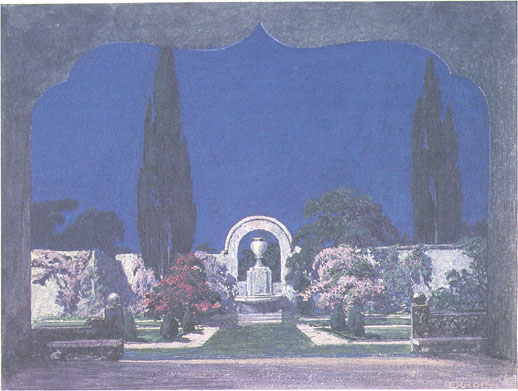
Fig. 23 Don
Giovanni, Giovanni's garden, 1913 (cat. 33)
Urban also employed what could be
described as mini-prosceniums within his settings, as
he had within his architecture, to frame scenic vistas.
Examples abound but might be noted particularly in the
garden scene of the Boston production of Don Giovanni,
whose Turkish arches framed an Art Nouveau garden and
a brilliant Urban–blue sky (fig. 23), or in Gasparo
Spontini's La Vestale at the Metropolitan Opera
in 1925 (fig. 24), in which a Roman triumphal arch framed
the Roman city beyond. These portals not only served
as focusing devices but, by allowing the spectator only
a limited view of a vista, suggested a much larger expanse
and far greater detail. The scenes glimpsed through these
arches were, like Shakespeare 's poetic evocations of
scenery, suggestive and thereby allowed the spectator's
imagination to complete the image in far greater detail
than possible with the scene painter's creation.
Urban was not merely the designer,
he was also the stage director for many of the operas
that he worked on – something that may surprise
us. The rising prominence of the director and increasing
specialization of the designer through the twentieth
century has encouraged a separation of these roles. Contemporary
audiences now associate the combined director–
18
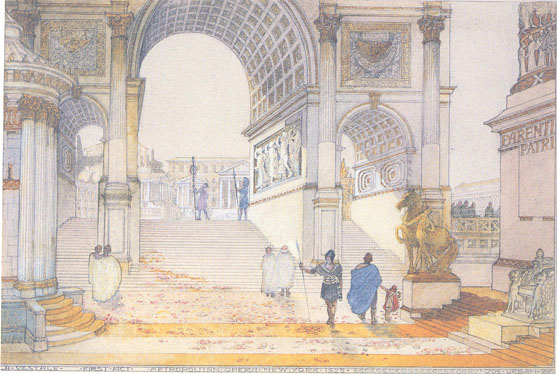
Fig. 24 La
Vestale, 1925, watercolor, 8% x 13 in.
Rare Book and Manuscript Library, Columbia University
[Show
larger image]
designer either with avant–garde
artists, such as Robert Wilson, or the creators of spectacle,
such as Franco Zeffirelli. But early in the twentieth
century, Urban was exercising a significant artistic
control and as such he was able to bring innovations
to the staging and acting while fusing the visual and
performative elements of the opera into a unified whole.
The Boston critic H.T. Parker, an early advocate of the
New Stagecraft, was rapturous in his praise, writing
that in The Tales of Hoffmann, Urban "freed
the singing–players from the outworn conventions
of operatic acting, persuaded them to sink themselves
into their parts and to adjust their parts to the play."28 Parker
went on to prophesy that "some day, the records may
say that a revolution in the setting and lighting of
the American stage dates from the innovations at the
Boston Opera House."29
Two of the primary sources for the
New Stagecraft were the Swiss designer Adolphe Appia
(ten years older than Urban) and the English designer
and director Edward Gordon Craig (born the same year
as Urban). Appia set out to resolve the false dichotomy
between two–dimensional scenery and the three–dimensional
plasticity of the actor. He abandoned illusionistic decor
for the sculptural space of the stage and took advantage
19
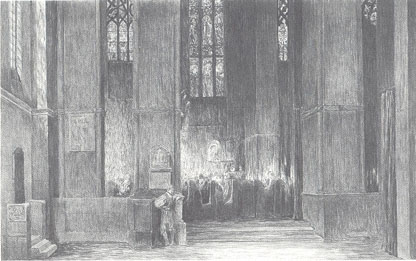
Fig. 25 Die Meistersinger von Nurnberg, inside
Saint Katherine's Church, 1908 (cat. 24)
of the new technology of electric
light to revolutionize stage illumination, literally
sculpting space with light. He did not reject decor altogether,
and particularly in his designs for Wagnerian opera he
created a suggestive and impressionistic style of scenery
that evoked mood more than specific locale. Craig similarly
rejected the trompe–l'oeil stage of the nineteenth
century. His signature contribution was a system of moving
screens that could constantly transform the space of
the stage. His designs often involved towering pillars
and walls that gave his settings a sense of grandeur.
Craig and Appia clearly had an impact
on Urban. As early as 1908 a Craig–like massing
of strong vertical, angular columns and steps can be
seen in Urban's design for Wagner's Die Meistersinger at
the Vienna Opera (fig. 25). But unlike the soaring, almost
gravity–defying semi-gothic creations of Craig,
Urban's early attempt seems earthbound and heavy. A
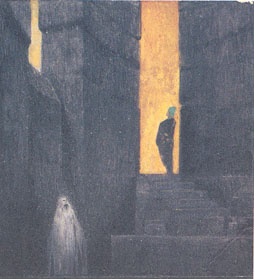
Fig. 26 Parsifal,
Klingsor's magic castle, 1914 (cat. 36)
few years later, a similar approach
was used in his Boston Parsifal (fig. 26). Notably, Urban
the colorist comes through even amidst the shadowy gray
tones inspired by Craig and Appia. A fiery orange sky
is visible through two angular gray columns. Whereas
these designs show a presumed influence of Craig, his
sacred forest for Parsifal at the Metropolitan
Opera (fig. 27), produced in 1920, seems to be a virtual
copy of Appia's 1896 rendering of the same scene (fig.
28). This Appian approach to the forest makes a telling
contrast with the forest from act 5 of Liszt's St.
Elizabeth from 1918 (fig. 29) The treatment of the
individual trees is similar, but the massing of them
and the use of color in the latter created something
more akin to Urban's fairytale illustrations.
Several members of the new generation
of American designers at the start of the twentieth century
studied with Appia, Craig, and others in Europe. Notable
among the young Americans were Robert Edmond Jones
20
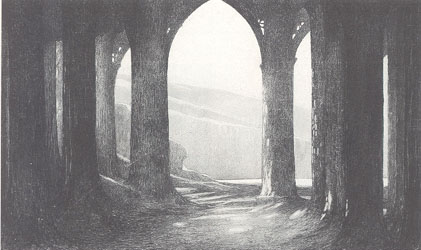
Fig. 27 Parsifal, sacred
grove, 1920 (cat. 41 a)
[Show
larger image]
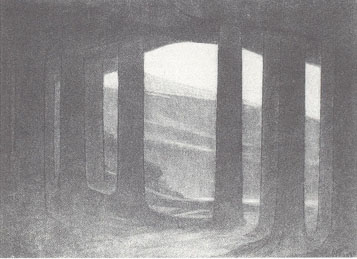
Fig. 28 Adolphe Appia, Parsifal, sacred
grove, 1896. Collection Suisse du Theatre, Bern
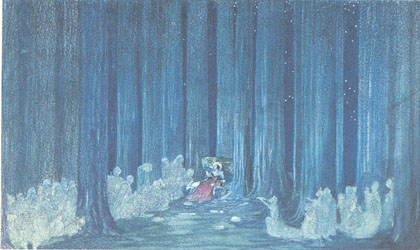
Fig. 29 St.
Elizabeth, woods, 1918 (cat. 39)
[show
larger image]
and Lee Simonson. According to the
now accepted history, the first example of the New Stagecraft
to be produced in America was Jones's design for Anatole
France's Man Who Married a Dumb Wife at New
York's Wallack Theatre in 1915 (fig. 30). The play served
as a curtain–raiser for the English director Harley
Granville–Barker's production of George Bernard
Shaw's Androcles and the Lion. Jones's setting,
done in shades of black, white, and gray – like
much of the work of Appia and Craig – used simple
geometric shapes, creating the impression of a wood–block
print, vaguely Japanese in feeling but also medieval.
Because it was done on Broadway and was unlike the standard
Broadway fare, the set received significant press (both
positive and negative), which helped to establish the
apparently new movement and lent credence to the appealing
story of a single production giving birth to a new aesthetic.
The fact is that more than six months earlier, the designer
Samuel J. Hume had mounted a highly touted exhibition
of new European stage design at his studio in Cambridge,
21
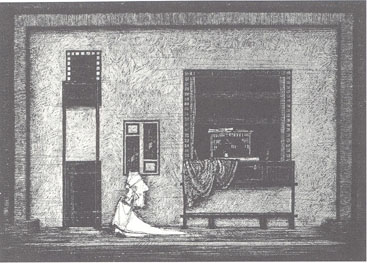
Fig. 30 Robert Edmond Jones, The Man Who Married
a Dumb Wife, revised sketch, 1915.
Whereabouts Unknown
Massachusetts, which was subsequently
mounted in a Fifth Avenue gallery in New York City. More
important, of course, were the three seasons of Urban's
Boston Opera productions. His setting for act 2 of Puccini's Madama
Butterfly (fig. 31), in particular, is remarkably
similar to Robert Edmond Jones's supposedly groundbreaking
design three years later.
Urban's Madama Butterfly was
composed almost entirely of rectangles surrounded by
a decorative geometrical frame. The arrangement of shapes
was, in essence, a blueprint for Jones's later version.
Urban was strongly influenced by the Wiener Werkstatte – the
Viennese arts and crafts movement with its reliance on
geometric detail and decorative line – and this
production and many others reflect that aesthetic. Werkstatte–like
decor also informs many of Urban's Broadway interiors.
It is instructive to compare the Madama Butterfly to
his fundamentally similar elevation for the Werkstatte–inspired
bedroom in the Redlich Villa in Vienna (fig. 32) with
its surface carved into rectangular blocks offset by
geometric
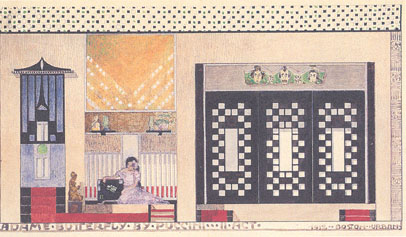
Fig. 31 Madama
Butterfly, inside Butterfly's house (detail),
1912 (cat. 310)
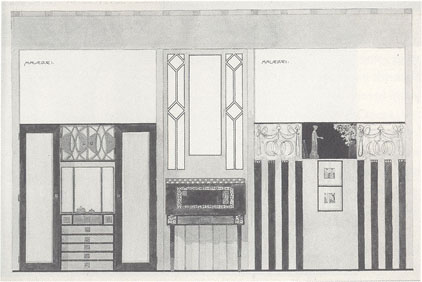
Fig. 32 Redlich Villa, Elsa Redlich's bedroom, 1907 (cat.
6)
22
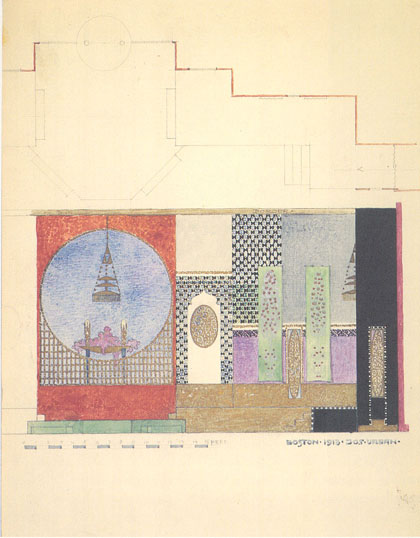
Fig. 33 Djamileh, elevation and ground plan, Haroun's
palace, 1913 (cat. 32)
decorative motifs. The pattern can
be seen again in the 1913 design for Bizet's Djamileh (fig.
33) in Boston. One significant difference between the
Urban and Jones designs is the use of color. The bold
black–and-white checkerboard patterns of the stage
left window unit of Butterfly are surrounded
by a palette drawn from the blue–violet end of the
spectrum, with exclamatory red highlights along the bottom.
Jones introduced color to his setting only through the
costumes.
But in 1915, any theater or art done
outside of New York City remained essentially invisible
(and in theater, at least, the situation has not changed
all that much). Urban attracted the attention of the
cognoscenti, but the real recognition ultimately went
to Jones because he was the first to be seen in New York.
COLOR AND ART NOUVEAU
Joseph Urban, first and foremost,
was a colorist. All of his innovations –on the stage,
in architecture, and in decoration – can be tied
to his unprecedented use of color, which was virtually
unmatched in the twentieth century. His appreciation
of color was heightened by his eight–month stay
in Egypt when he was nineteen.
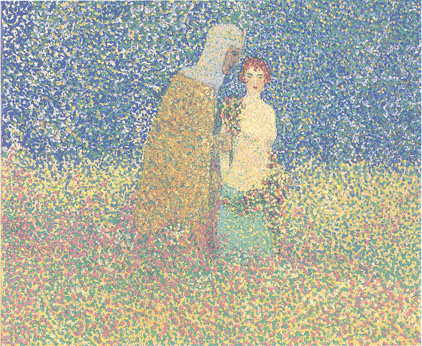
Fig. 34 Fairytale illustration, n.d. (cat. 23)
[MISSING
TEXT] er, Vuillard, Maillol, and
others) valorized color as a tool for emotional communication. "We
can no longer reproduce nature and life by more or
less improvised trompe 1'oeil," declared Maurice
Denis, "but on the contrary, must reproduce our
emotions and our dreams by representing them, using
forms and harmonious colors."32 The
bold, expressive use of color came to dominate a
wide range of arts across Europe at the turn of the
century. It is especially evident in the work of
two artists who had a strong influence on Viennese
developments, Edward Burne–Jones and Ferdinand
Hodler. In Vienna, the symbolist approach to color
was most pronounced in the paintings and decor of
Gustav Klimt, whose use of line, form, and
24
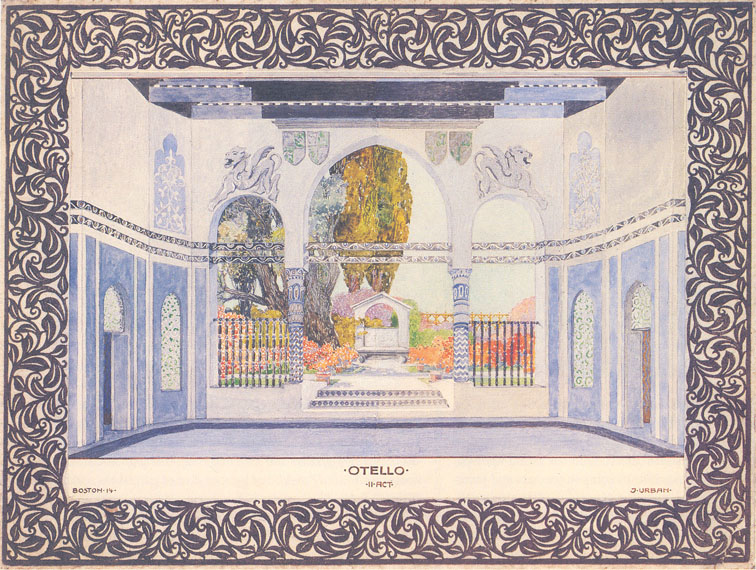
Fig. 35 Otello,
Desdemona's garden, 1914 (cat. 35)
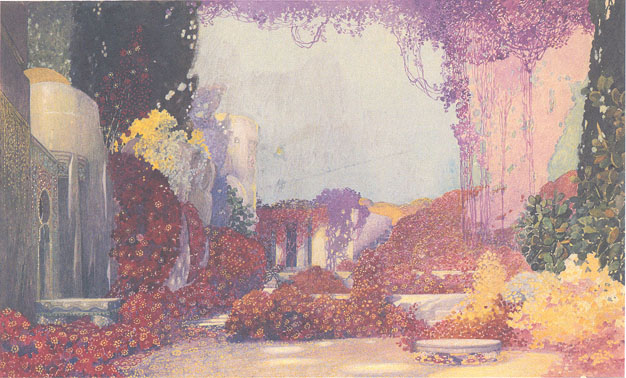
Fig. 36 Parsifal,
Klingsor's garden, 1920 (cat. 41b)
[Show
larger image]
color seems to anticipate or parallel
Urban's scenic style.
But the artist whose work most clearly
correlates to Urban's in its use of color and technique
is Georges Seurat. The shimmering colors that Urban achieved
on the stage were created through a variation of Seurat's
pointillist technique, which broke up color into its
component parts and juxtaposed complementary colors in
a seemingly abstract mosaic pattern that, when seen in
toto, created a unified image. Urban can be seen using
this technique early on, in one of his book illustrations
(fig. 34) in which the "points" of color are
quite pronounced. Urban painted scenery not as an illusionist
imitation of nature but, as one writer put it, "as
a medium for the reception of colored light."33 Urban
understood that color on the stage (as opposed to on
an artist's canvas) is a result of the particular combination
of paint pigments and stage lighting – red pigment,
for instance, becomes visible only under red light or
the red part of the spectrum within "white" light.
Thus, instead of covering a canvas with flat expanses
of paint as had been the practice of most scene painters,
Urban took a semi–dry brush and spattered it. For
his skies, for example, he used several shades of blue
spattered over each other, then further spattered the
canvas
25
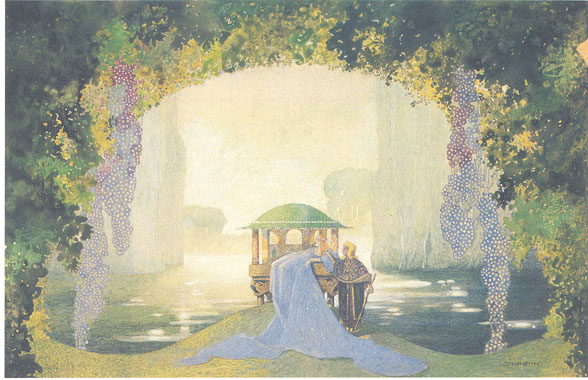
Fig. 37 The
Garden of Paradise, queen's bower, 1914 (cat.
47)
[Show
larger image]
with red, green, and silver.34 In
the scene shop, under work lights, the resultant painting
looked gray, but on the stage colored light employed
with subtlety picked up and reflected the differing flecks – Urban
could create anything from dawn to moonlight. The effect
was "as suggestive of reality," claimed Macgowan, "as
is any painting by Monet."35 The fragmented
palette created a luminous, shimmering effect that repeatedly
evoked the word "magical" from critics and observers.36
.
Urban's palette was not limited to
blue, nor was his technique limited to pointillage. As
with his Jugendstil or Art Nouveau colleagues, he drew
upon the brilliant colors and undulating forms of exotic
flowers and foliage, the mysteriously patterned world
seen through the microscope, and other enigmatic examples
of nature; there was also a distinct influence of Japanese
prints and other Asian forms. This could be seen over
and over in his repeated use of dripping foliage, as
in the garden viewed through the portals of Verdi's Otello at
Boston in 1914 (fig. 35); the ultimately unused garden
for the Met's 1920 Parsifal (fig. 36); and The
Garden of Paradise designs (fig. 37); as well as
the murals of the Ziegfeld Theatre (fig. 38) and the
murals and ceilings of many restaurants and hotels, such
as the
26
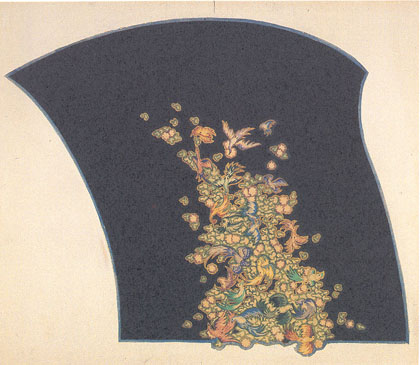
Fig. 38 Ziegfeld
Theatre, mural for balcony ceiling, 1926–27
(cat. 9c)
St. Regis Hotel roof garden (fig.
39), the Central Park Casino, or the elevators of Bedell's
department store (fig. 40). These designs used a dizzying
array of pastels and drew heavily from the red and violet
end of the spectrum. Such a palette was alien to the
turn–of-the-century naturalists and literalists,
and was seemingly anathema to the Jones–Simonson
school of New Stagecraft with its monochrome palette.
Related to Urban's use of color was
his sensuous treatment of line. With precedents in the
arts and crafts movement and symbolism, and with a conscious
nod toward medieval art and orientalism, Art Nouveau
was
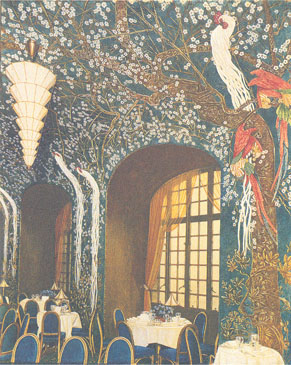
Fig. 39 St.
Regis Hotel, New York, murals for roof garden dining
room, 1927–28 (cat 10)
typified by a provocative and decorative
use of line – "line determinative, line emphatic,
line delicate, line expressive, line controlling and
uniting" as Walter Crane, an artist influenced by
William Morris, put it in 188937 – which
functioned visually much as sound had in symbolist poetry.
Line, as the art historian Peter Selz explained, "became
melodious, agitated, undulating, flowing, flaming."38 Such
adjectives well describe the sinuous lines of many of
Urban's illustrations from the 1890s, most done in collaboration
with his brother–in-law Heinrich Lefler, as in the
underwater castle image in Chronika der drei Schwestern (Chronicle
of the Three Sisters)
27
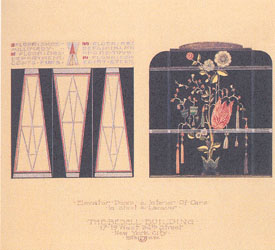
Fig. 40 Bedell
Store, elevator doors and interior of cars, 1928
(cat. 12b)
from 1899 (fig. 41). This use of line
is a crucial element in his drooping foliage patterns
and murals, recurs constantly in various Follies productions,
and emerges rather startlingly in the Aubrey Beardsley–like
tableau curtain of "Tinturel's Vision" for the
Met's Parsifal (fig. 42) or the Erte–like
curtain for Lohengrin (fig. 43). With the exception
of some Ballets Russes designs, such use of line was
rare on the stage throughout this period except in the
work of Urban. It was particularly striking when juxtaposed,
as it sometimes was, against the geometric forms of the
Werkstatte–inspired designs.
The complete marriage of line and
color, not surprisingly, found its most triumphant form
in Urban's architecture; and nowhere was this more brilliantly
demonstrated than in the Ziegfeld Theatre. As Urban himself
characterized it, it was to be a place where "people
coming out of crowded hours and through crowded streets,
may find life carefree, bright and leisured."39 The
interior was designed with no moldings so that everything
would flow together smoothly, "like the inside of
an egg," and the
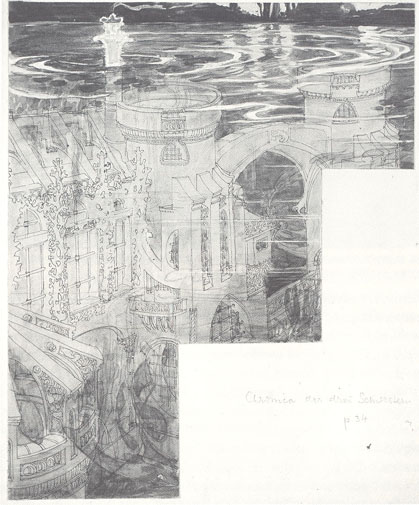
Fig. 41 Chronika der drei Schwestem, 1899 (cat.
2)
28
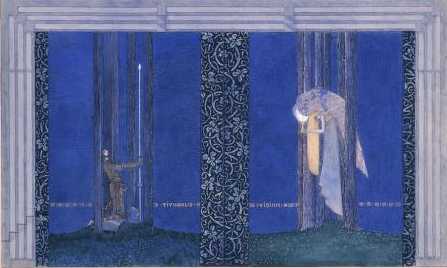
Fig. 42 Parsifal,
tableau curtain showing "Tinturel's Vision," 1920,
watercolor, 12 x 16 3/8 in.
Rare Book and Manuscript Library, Columbia University
[Show
larger image]
decor was envisioned as a single,
unifying, encompassing mural. "The carpet and seats," explained
Urban, "are in tones of gold, continued up the walls
to form the base of the mural decoration where heroes
of old romance form the detail in flowering masses of
color interspersed with gold." For Urban this was
not merely decoration, however, but a carefully thought–out
scheme for enhancing the experience of the spectators – focusing
them on the stage during the performance and bathing
them in warmth during intermissions. "The aim . .
. was to create a covering that would be a warm texture
surrounding the audience during the performance. In the
intermission this design serves to maintain an atmosphere
of colorful gaiety and furnish the diversion of following
the incidents of an unobtrusive pattern." This design
scheme was as much an example of architectural gesamtkunstwerk as
Wagner's opera house at Bayreuth, perhaps even more so.
Because it was now employed in the service of popular
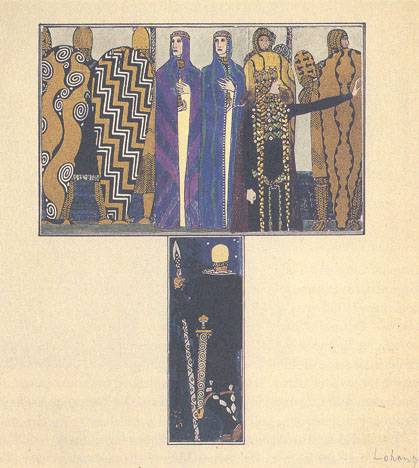
Fig. 43 Lohengrin,
curtain, 1909–11 (cat. 25)
29
entertainment, however, it was never
accorded the same status or respect. (Interestingly,
just as Wagner hid the orchestra from view so as not
to detract from the idealist vision created on the stage,
Urban hid his equivalent of the orchestra: the lighting
equipment. Light was crucial in bringing his creations
to life and in giving movement to the architectural forms,
but in both interiors and exteriors, the sources of illumination
remained hidden so as not to seem like afterthoughts
or to interfere with the desired effects.)
By contrast, Urban's Paramount Theatre,
a movie house in Palm Beach, Florida, was simple in its
lines and employed a subdued palette of silver and green, "cool
and comfortable" (fig. 55). The rationale was simple:
the rhythms of Palm Beach were "leisured and sunny" as
opposed to those of New York City. "The theatre," explained
Urban, "is not an escape from the life around, but
a part of it, fitting into the rhythm of the community.
The architecture of the Paramount Theatre ... is accordingly
simple, spacious, Southern."
Urban was a forceful advocate for
the use of color in architecture – to
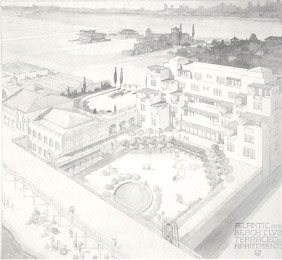
Fig. 44 Atlantic
Beach Club, Long Island, terraced apartments, 1929-31
(cat. 20)
shape the mood and enhance the functions of interiors,
and to transform entire cities through the application
of color to exterior surfaces. Urban, in fact, saw cities
as virtual stage settings, which needed color to bring
them to life. "When the morning sun gilds the city
and casts blue shadows," Urban wrote in 1927,
even the buildings of
neutral coloring are often very beautiful, but there
are many hours when these effects are not seen and there
are gray days. Then our buildings need positive colors
to enliven them. When we look at the city at night, we
see light in many tones. Some are dazzling white, others
are soft and warm. A building can have the same distinctiveness
in the daytime. Its color can express its personality.
These colorful structures will have charm on gloomy days
as well as when the sunlight tints them, and at night
all degrees of the lights and shadows of artificial illumination
will have their part in modifying and enhancing them.40
The Atlantic Beach Club (1929–31)
on Long Island was an example of this approach (fig.
44). The walls and decks were composed of surfaces of
red, yellow, blue, and white stucco which served as a
background for brilliantly colored awnings and umbrellas.
By the 1930s Urban was moving into bolder experiments
with architectural color. The interior of the New School
for Social Research's new home on West 12th Street in
New York City (fig. 45), which opened in 1930, provided
a particular challenge – a large number of rooms
and auditoriums in a relatively small space with each
room having a specific function. Urban used large masses
of bright color on plaster surfaces to establish relationships
among the spaces while distinguishing them as necessary. "The
color is in fact the form, the volume," observed
the architect Otto Teegen. "One does not feel that
certain architectural surfaces have been painted, but
that these architectural planes and volumes are actually
color planes and color volumes which have been composed
to make a room or a library, as the case may be."41According
to Urban, warm colors were located
30
where they receive the
most light, cold where there is most shadow, a change
of plane is generally emphasized by a change of color,
thus the walls have one set of colors, the ceiling another.
By thus modeling the wall surfaces of a room the boxlike
property of four walls is given an expression of contrasting
filled spaces and void space; the monotony of the enclosing
areas is transformed to an imaginative statement of the
space enclosed and given a character by the emotional
statement of color.42
It was the critic Edmund Wilson who
this time criticized the building for its theatricality. "When
he tries to produce a functional lecture building," complained
Wilson, "he merely turns out a set of fancy Ziegfeld
settings which charmingly mimic offices and factories
where we keep expecting to see pretty girls in blue,
yellow and cinnamon dresses to match the gaiety of the
ceilings and walls."43
Building on the New School experience,
Urban saved his boldest architectural color work for
what was to become the last project of his life, the
International 1933 Century of Progress International
Exposition in Chicago, for which he was appointed director
of exterior color and consultant on lighting. His plan
seemingly amalgamated the Nabis approach of saturated,
emotion–charged colors with Bauhaus-like surfaces
of geometric planes (fig. 46). He aimed to create a unified
approach to color for the entire fair – color as
an architectural medium, not decoration. He set out six
guiding principles:
- Color to be used in an entirely
new way.
- Color used to co–ordinate
and bring together all these vastly different buildings.
- Color to unify and give vitality.
- Color to give brightness and
life to material not beautiful in itself.
- Color to give the spirit of carnival
and gaiety – to supply atmosphere lacking in our
daily life.
- Color that should transport you
from your everyday life when you enter the fairgrounds.44
He created a palette of twenty–four
colors, all of the "brightest intensity": 1 green,
2 blue–greens, 6 blues, 2 yellows, 3 reds, 4 oranges,
2 grays, white, black, silver, and gold. The plan was
for approximately 20% of all surfaces to be white, 20%
blue, 20% orange, 15% black, and the remaining 25% to
be spread among the yellows, grays, greens, and silver.45 It
is one thing, of course, to create such a bright and
vibrant color scheme for a world's fair, quite another
to transform a functioning city.

Fig. 45 The
New School for Social Research, New York, dance studio,
1930 (cat. 19c)
31
ZIEGFELD FOLLIES
Despite his numerous brilliant productions
for the Metropolitan and Boston operas and despite his
major architectural works, Urban became – and remains
- best known for his work with Florenz Ziegfeld.
Following the closing of the Boston
Opera, Urban went to Paris with the company in July 1914
to direct Wagner's Tristan und Isolde – the
first German opera presented there in thirty years – but
the outbreak of the war stranded him in Europe. The producer
George Tyler, however, managed to bring him back to New
York to design a production of Edward Sheldon's Garden
of Paradise, which became Urban's first Broadway
show. The production itself was a failure, but Urban's
sets and new aesthetic attracted attention. The nine
fantastical scenes included a castle, a storm at sea,
a fairy bower, and a sequence under the ocean. In a contemporary
article on the production, the writer Louis DeFoe seemed
to understand that the New Stagecraft had arrived:

Fig. 46 Century of Progress International Exposition,
Chicago, 1933, watercolor, 13 x 33 in. Rare Book and
Manuscript Library, Columbia University
But the scene changes were unwieldy
and necessitated close to an hour's worth of intermissions,
which contributed to the demise of the show. With the Follies,
at least, Urban would never make that mistake again.
He learned how to make scenery move as if it were music.
Among the few people who saw The
Garden of Paradise was Florenz Ziegfeld, who was
looking for a designer to give the annual Follies (which
had premiered in 1907) a more sophisticated look. He
hired Urban – who had never seen the Follies – and
took him out to Indianapolis to catch up with the 1914
edition on tour. Urban's first – and accurate
- impression was that the show was little more than
a series of disconnected sketches which were equivalent,
in his words, to "advertising posters." He
was going to bring his gesamtkunstwerk approach
to Ziegfeld. "I hope most of all to unify the impression
of all these short scenes, to give the entire evening
a kind of keynote," he declared.47 The Ziegfeld
Follies of 1915, Urban's first, astounded audiences,
in part because of the lavish settings for its twenty–one
scenes, but just as important for the way in which
those scenes flowed from one to the next so that the
entire revue seemed to be a single, unified entity.
One of the techniques that Urban had to master was
the basic vaudeville device of the "in one" scene – an
interlude played in front of a downstage drop curtain
that allowed large set changes to occur behind it.
Some critics bemoaned the fact that a great opera designer
was descending into the lower depths of crass commercial
and mass entertainment,
32
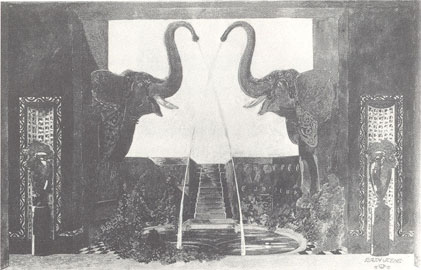
Fig. 47 The Ziegfeld
Follies of 1915, bath scene (cat. 49c)
[Show
larger image]
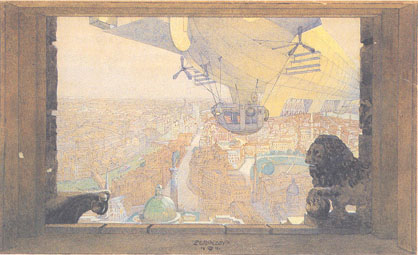
Fig. 48 The Ziegfeld
Follies of 1915, zeppelin over London (cat.
49b)
[Show
larger image]
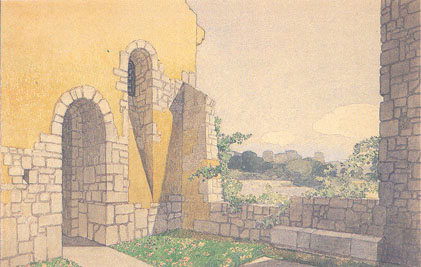
Fig. 49 Macbeth,
outside the castle, 1916 (cat. 53)
[Show
larger image]
forgetting that opera had evolved
in large part from baroque intermezzi – the lavish,
allegorical spectacles created by leading architects
and painters of the seventeenth century using fundamentally
the same staging techniques as modern revues and extravaganzas.
History had merely come full circle. (One wonders about
the potential effect on twentieth–century theater
if Appia, Jones, or Bakst had been forced to master and
absorb the ancient crafts and techniques of popular scenography.)
The 1915 Follies included
one of the most spectacular Ziegfeld scenes to that time – the
bath scene (fig. 47), in which two smiling, golden elephants
spouted water from their raised trunks into a pool of
water surrounded by Jugendstil–like shrubbery. Kay
Laurell as Aphrodite rose out of the pool to signal the
start of a mermaid ballet. The staircase behind the pool
was also the first hint of the soon–to-be-famous
Ziegfeld staircase that would showcase the chorus of
Ziegfeld girls. The staircase became
33
central element in The Century
Girl, produced by Ziegfeld and Charles Dillingham
and designed by Urban at the Century Theatre the next
year, and then appeared regularly in the Follies thereafter.
The 1915 Follies was also to contain the stunning
drop of a zeppelin hovering over London (seemingly,
though impossibly, viewed from St. Paul's Cathedral)
(fig. 48) for a skit with the comedians Bert Williams
and Leon Errol. The skit was originally to be in a
submarine, but after more than a dozen rewrites, which
was typical of the Ziegfeld process, the setting was
changed to a zeppelin, and finally the whole thing
was cut during out–of-town tryouts.48 Although
Urban provided the Follies with a sense of
visual style and lavishness that was unsurpassed, as
well as an all–important artistic unity, his designs
were capable of overwhelming the whole production,
even with its enormous star power. A review of the
1917 Follies praises Urban's sumptuous settings
and notes that in his "Oriental setting, [he] has
outdone himself in his employment of colors and seemingly
massive structures," but goes on to protest that
while in richness of
tone and in suggestion of distance the setting is superb,
it, nevertheless, obtrudes upon the players in the foreground.
There is no personality definite and dominant enough
to stand against it successfully, and therefore most
of the fun and satire that had been contrived for the
scene went for naught.49
The significance of Urban's work with
Ziegfeld was in bringing artistic excellence, visual
wit, and a sense of opulence to popular entertainments.
Moreover – and quite astonishingly - he introduced
the aesthetics of Wagnerian gesamtkunstwerk and
the scenic innovations of the New Stagecraft to Broadway.
The New Stagecraft as presented by Robert Edmond Jones,
Lee Simonson, Sam Hume, and others was spare, dark, serious,
and pregnant with meaning and import; Urban presented
scenographic inspiration as frothy dessert for audience
consumption, perhaps never fully realizing its significance.
But it laid the groundwork for Broadway musicals for
the rest of the century and for the Hollywood musicals
of the 1930s and the extravaganzas of Busby Berkeley.
Urban created, in other words, a new scenic and visual
vocabulary that permeated popular consciousness.
Urban, as an outsider in American
culture, saw the puritan streak that ran through the
culture, particularly its attempt to separate high and
low art. But he also understood that the two were not
necessarily separate.
I believe you can make
your fun and your pleasure and your diversion artistic
as well as your more serious plays. In America you have
seemed to feel that you must do serious things seriously,
but that you can do things meant for pastime very carelessly.
That ought not to be so. You ought to take just as much
care in providing your fun as you do your education.50
CONCLUSION
Urban made a very conscious decision
to stay in the United States, and he became a naturalized
citizen in 1917. Unabashedly pragmatic, he declared that
the economic situation in the United States was far more
conducive to the development of the scenic art than that
of war–torn Europe, and he believed that New York
was about to become the center of the design world.51 While
his American colleagues looked to Europe for inspiration
and artistic leadership, Urban absorbed the democratic
American spirit that valorized popular culture and freely
mixed so–called high and low art. At least one historian
has wondered if Urban's place in history might have been
greater had he remained in Europe.
Urban's pragmatism included his belief
that the theater could be an arbiter of taste, that like
architecture, interior design, and crafts, it could shape
the cultural sensibility of the spectators. "If only
one person each night sees something in my stage settings
which quickens his or her interest in beauty, I shall
be supremely happy."52 But this Werkstatte–inspired
aestheticism was not in keeping with seriousness of the "art
theater." The cutting edge was to be found in the
so–called Little or Art Theaters of the
34
day, such as the Provincetown Playhouse
where the plays of Eugene O'Neill were first produced.
The monochromatic, sculptural, expressionist settings
created by Jones, Simonson, Cleon Throckmorton, Sam Hume,
Norman Bel Geddes, and others were more appropriate for
the neosymbolist, quasi–expressionist plays emerging
from the hands of the new American playwrights of the
teens and twenties – with their probings of the
psyche and the dark inner workings of the soul – than
were the colorful and often decorative creations of Joseph
Urban. The dark, suggestive scenographic creations of
Jones and his colleagues also lent themselves to the
new psychological stagings of Shakespeare and other classics
being mounted by Arthur Hopkins and later by Margaret
Webster and Eva Le Gallienne. Again, Urban's often colorful
fantasies seemed out of place. (His rather sunny 1916 Macbeth [fig.
49], for instance, provides a vivid contrast to the somber
tone of most contemporary Shakespearean productions.)
As a result, the work of designers such as Jones, Simonson,
and Bel Geddes was seen as art, while that of Urban was
categorized as decoration. And the Follies,
providing a bourgeois and upper–class clientele
with spectacle and pulchritude (tasteful and sophisticated
though it may have been), were either ignored or denigrated
by literary and art critics. Ironically, Urban may also
have been harmed by his prodigious creations in such
a wide area of endeavor. In 1930 an article on the designer
drew a fanciful but theoretically feasible picture of
Urban's range and interaction with his audience.
It is possible for a
person to walk out of a house designed by Urban, to pack
one's clothes in a trunk he designed, to go for a ride
in an automobile of his design, to drive to a theater
of his creation to see a show for which he did the sets,
then to go to any one of a number of restaurants or nightclubs
he decorated, and after dining to spend the night in
a hotel, the furnishings and decorations of which again
reflect Urban.53
As much as we might admire the range
of this seemingly Renaissance individual, it made him,
to some degree, suspect. Many of the leading theater
practitioners at the beginning of the twentieth century
were attempting to establish theater as an art, as opposed
to an entertainment. Edward Gordon Craig entitled
the major collection of his essays On the Art of
the Theatre; Stanislavsky called his autobiography My
Life in Art, and his company was the Moscow Art
Theatre (just as Georg Fuchs had founded the Munich Art
Theatre). A person who designed furniture, interiors,
industrial products, restaurants, and nightclubs, however,
was at best an artisan or a craftsman. Adolphe Appia,
after all, did not design kitchenware, Robert Edmond
Jones did not design luggage. (Norman Bel Geddes, it
is true, actually made his mark as an industrial designer – he
was largely responsible for the "streamlined" look –but
had less impact as a stage designer.)
Joseph Urban's legacy is still felt
on Broadway in the musical theater designs of Robin Wagner
(and before him, in the work of his mentor Donald Oenslager)
and in the Andrew Lloyd Webber extravaganzas. Echoes
of Urban, if not his direct influence, can be discerned
in the rich blue tones of Robert Wilson productions,
not to mention Wilson's mixing of modernist design and
crafts with scenography. The theatricality of much postmodern
architecture, notably that of Frank Gehry, has precedents
in Urban's work. Urban's influence could be explicitly
seen in the New York World's Fairs of 1939 and 1964–65
and of other similar expositions. It is seen in the developments
of the new Times Square with its unabashed use of color
and advertising marquees and in much contemporary theater
in which art and entertainment dissolve into one another.
And it exists wherever bold colors and undulating lines
create a world of wonder and fantasy. Joseph Urban should
hold a place as one of the most significant figures in
the twentieth–century design and architecture.
Perhaps the twenty–first century will correct the
oversight.
Arnold Aronson is a professor of
theater at Columbia University and former chair of
the Theatre Division. He writes frequently about scenography.
35
. NOTES
- Sigmund Freud, On Dreams (New
York: W. W. Norton, 1965; orig. pub. 1901) 97,99.
- Quoted in Frantisek Deak, Symbolist
Theater: The Formation of an Avant–Garde (Baltimore:
Johns Hopkins University Press, 1993) 145.
- Quoted in Randolph Carter and Robert
Reed Cole, Joseph Urban: Architecture., Theatre,
Opera, Film (New York: Abbeville Press, 1992)
183.
- Deems Taylor, "The Scenic Art
of Joseph Urban: His Protean Work in the Theater," Architecture 69
(May 1934): 290.
- Quoted in Hans Bisanz, "The
Visual Arts in Vienna from 1890 to 1920," Vienna
1890–1920, Robert Waissenberger, ed. (New
York: Tabard Press, 1984) 116.
- Gaston Bachelard, The Poetics
of Space (Boston: Beacon Press, 1964) 6.
- H.T. Parker. "The Opera Outdoes
Itself ... 'The Tales of Hoffmann' Produced as Never
Before in America," Boston Evening Transcript (26
November 1912).
- From the Sunday Leader.
Typed manuscript in the Joseph Urban Collection (box
34, file 5), Rare Book and Manuscript Library, Columbia
University (hereafter JUC).
- Jane Kallir, Viennese Design
and the Wiener Werkstatte (New York: Galerie
St. Etienne/George Braziller, 1986) 22
- See Carl Schorske's "Introduction" to
Kallir's Viennese Design, especially page
8; for a far more extensive investigation, see his
book Fin–de-Siecle Vienna: Politics and Culture (New
York: Vintage Books, 1981).
- Kallir, Viennese Design,
49.
- Frank Cadie, "Excels Because
He Does Not Specialize," Brooklyn Eagle Magazine (30
March 1930).
- Ibid.
- Kallir (Viennese Design,
22) cites the factual refutation of this story but
notes that it has persisted because of its plausibility.
- Joseph Urban, "Wedding Theater
Beauty to Ballyhoo," American Architect (20
September 1928): 361.
- Ibid.
- Joseph Urban, Theatres (New
York: Theatre Arts Press, 1929).
- Ibid.
- Shepard Vogelgesang, "Architecture
and Trade Marks," Architectural Forum (1929):
900.
- Urban, Theatres.
- Ibid.
- Kenneth Macgowan, "The New Stage–Craft
in America," Century Magazine 65 (January
1914): 418.
- Ibid., 416.
- Ibid.
- Ibid., 418.
- Typescript, JUC (box 34, file 5).
- Macgowan, "New Stage–Craft
in America," 418.
- H.T. Parker, "Opera Outdoes
Itself."
- Ibid.
- Manuscript, JUC (box 34, file 5).
See also Otto Teegen, "Joseph Urban's Philosophy
of Color," Architecture 69 (May 1934):
257.
- John Corbin, "The Urban Scenery
and Some Other Matters," New York Times (30
September 1917): III.8.
- Maurice Denis, "From Gauguin
and van Gogh to Neo–Classicism," in Art
and Theory 1900–1990, Charles Harrison and
Paul Wood, eds. (Maiden, MA: Blackwell Publishers,
1993)51.
- Taylor, "Scenic Art of Joseph
Urban," 276.
- Ibid. 279.
- Macgowan, "New Stage–Craft
in America," 421.
- See, for example, Hiram Kelly Moderwell, The
Theatre of To–day (New York: John Lane,
1914) 103.
36
- Quoted in Peter Selz, "Introduction," Art
Nouveau: Art and Design at the Turn of the Century,
Selz and Mildred Constantine, eds. (New York: Museum
of Modern Art, 1959) 10.
- Ibid. 39. Urban, Theatres.
All subsequent quotes relating to the theaters are
from the same source. 40. Quoted in Teegen, "Joseph
Urban's Philosophy of Color," 262, 265.
- Ibid., 261.
- Quoted in Carter and Cole, Joseph
Urban, 204.
- Ibid. Though generally well received,
Urban's architectural design was particularly criticized
by the architect Philip Johnson for the way in which
it mimicked the International Style while failing to
have form rigorously adhere to function – the
design remained far too decorative for Johnson's taste.
- JUC (box 34, file 5).
- Ibid.
- Louis DeFoe, "A New Experiment
with the Fairy Play," Greenbook Magazine (February
19 15): 277.
- Oliver M. Sayler, "Urban of
the Opera, the Follies, and the Films" Shadowland (typescript,
JUC [box 34, file 3]).
- See Richard and Paulette Ziegfeld, The
Ziegfeld Touch: The Life and Times of Florenz Ziegfeld,
Jr. (New York: Harry N. Abrams, 1993) 73.
- Review of Ziegfeld Follies,
in Dramatic Mirror (23 June 1917).
- Sayler, "Urban of the Opera."
- "Our Scenic Art Leads the World," Sunday
World (18 January 1920).
- Ibid.
- Arthur Strawn, "Joseph Urban," Outlook
and Independent 555 (18 June 1930): 275.
37
ASSIMILATION & ECLECTICISM
THE ARCHITECTURE OF JOSEPH
URBAN
DEREK E. OSTERGARD
JOSEPH URBAN has been considered by
some critics and historians to be one of the leading
modernists working in the United States during the interwar
period, yet an examination of his work as designer and
architect reveals him to be less of a leader and more
of a follower, albeit one possessing remarkable, chameleonlike
gifts.1 Although these gifts are more difficult
to discern in his early career, they become clearly evident
following his emigration to the United States, especially
in the final decade of his life, when he reached the
pinnacle of his career. This extraordinary ability of
Urban to satisfy his client base, oftentimes at the expense
of originality, indicates, in so many respects, his true
brilliance and reveals that he was the product of the
complex world of his youth in late nineteenth–century
Vienna.
By the time of Urban's birth in 1872,
Vienna, as the capital of an enormous empire that had
undergone seismic shifts throughout the nineteenth century,
had embraced many of these changes while denying others.
The century had begun with Vienna as the capital of the
Holy Roman Empire and ended with the empire irreparably
compromised. In the course of that final century of its
existence, through war, treaty, and general policy, Vienna
saw the landmass of its empire erode in Western Europe
while it sought to consolidate its position in the east,
deeper into the Russian empire 's sphere of influence,
a decision that would produce dangerous consequences
by 1914.2
The Austrians were forced to contend
with a wide array of socioeconomic and political shifts
which were transforming the Continent throughout the
second half of the nineteenth century, and specifically,
they made numerous tactical errors in both their external
military operations and their internal political directives.
These situations would culminate in pronounced internal
administrative tensions within the government, reflected
in oftentimes unfortunate ethnic consequences that occurred
between the ruling elite and non–German subjects
of the empire, many of whom moved to Vienna to seek economic
and social opportunities while protecting their own hard–earned
achievements.
For Vienna this meant that, as capital
of this empire, it was increasingly peopled by a wide
array of ethnic and economic groups all jockeying for
power and position in a variety of fields. The prevailing
structure of power, however, was built upon the conservative
imperial court and the reactionary Roman Catholic Church.
Nevertheless, most of the artistic, economic, and political
achievements of the era must be credited to the ascendant
middle class to which Urban's family belonged and which
was intent upon preserving the prerogatives it had won
since the seminal revolution of 1848. The rise of various
ethnic groups which emigrated to the capital city after
the revolution, and the maneuvering of various economic
and political factions as society moved from an overwhelmingly
rural disposition to an increasingly industrial one,
resulted in that remarkable
38
phenomenon later known as the grunderzeit,
or the Time of the Founders.
It was during this period when imperial
Vienna itself was transformed into the multistylistic
metropolis whose architectural manifestations of historicism
were far more complex than any in Paris, London, or Berlin.3 This
was the intellectual and visual world that would define
Joseph Urban and his career from its earliest years until
his death in New York City in 1933. In many respects,
the multistylistic tendencies of Vienna's conservative
grunderzeit architects would provide him with a more
adaptable professional and aesthetic template than would
the work of Vienna's truly progressive architects such
as Otto Wagner (1841–1918), Josef Maria Olbrich
(1867–1908), and Josef Hoffmann (1870-1956). Urban's
ability to work in a wide variety of architectural idioms
would serve him well for more than a quarter of a century.
By the last quarter of the nineteenth
century, the artistic and design community in Vienna
was basically defined by a growing rift between the academic
and the avant–garde, a situation found in many other
major European cultural centers. In Vienna, designers
and architects joined painters in their revolt when the
younger, more avant–garde Austrian artists seceded
in May of 1897 from the conservative and discriminatory
artists' association known as the Künstlerhaus,
which had dominated the field of painting in Vienna through
the exhibitions held in its halls. The new, rival group – thereafter
known as the Secessionists – held its first exhibition
in March of 1898 and then conducted its second in November
of 1898 in the startling, purpose–built structure
designed by Josef Maria Olbrich (fig. 50). Olbrich, only
five years older than Urban, was already a leading figure
in the progressive design world of Central Europe, second
only to his mentor, Otto Wagner.4 Olbrich's
formation of an innovative language of design in the
final years of the 1890s would effectively clear the
ground around him of all serious competition, with the
exception of one contemporary, Josef Hoffmann.5
The slightly younger Hoffmann had
won praise at the end of the 1890s for his own Jugendstil
design with its sweeping curvilinear vocabulary imbued
with symbolic meaning. Following his success with it
at the 1900 Exposition Universelle in Paris, he quickly
abandoned this manner of work, abruptly and adroitly
shifting his design vocabulary to one that was markedly
symmetrical and geometric, and initially free of ornamental
elements. He would widely disseminate this revolutionary
vocabulary through his inauguration of the Wiener Werkstatte,
which executed a wide range of modernist decorative arts
for an elitist audience until 1932.
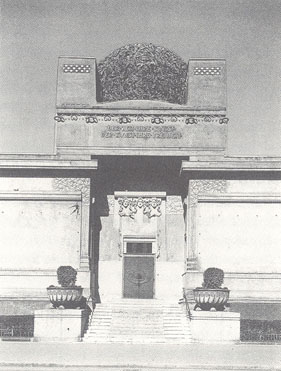
Fig. 50 Josef Maria Olbrich, Secession Exhibition Hall,
Vienna, 1897.
Photograph: Giorgio Pezzato
39
URBAN: THE EARLY YEARS
Joseph Urban must be seen in the context
of his slightly older contemporaries. Like Hoffmann,
Urban was not only forced to labor in the shadow of the
exceptionally gifted Otto Wagner, but he was also at
a disadvantage because he had not trained in Wagner's
atelier. Having been born into one of the principal centers
of modernism at the end of the nineteenth century, Urban
was additionally hampered in that the field of endeavor
for progressive architects and designers was already
excessively crowded with talent by the time he began
his practice.6
Between the turn of the century and
his departure for Boston in 1912, Urban seems to have
received relatively few commissions, especially when
one compares his career during this period with those
of Olbrich and Hoffmann. Nonetheless, Urban's early work,
although for a limited clientele, was highly visible
in that he worked for a prominent Hungarian family, the
Esterhazys, and he was commissioned by the imperial family
to produce two large–scale temporary installations
for important court functions.
The first of these, a bridge connecting
the Künstlerhaus and the Musikverein (fig. 8), was
perhaps the most original work of his Viennese years.
This powerful geometric endeavor of 1898, although temporary,
was remarkable for the way it linked two massive, academic,
historicist buildings with a form, ornament, and materials
that did nothing to unite it aesthetically with the two
extant structures. Certainly, the decorative vocabulary
used for this passageway by the young Urban was indebted
to the highly individual ornamental language that had
been so brilliantly developed by Olbrich during the two
previous years and which was well known to Urban by that
time.
Throughout Urban's career, he would
reveal an ability to garner high–profile clients.
An early indication was the several commissions from
Count Karl Esterhazy at the turn of the century (figs.
2, 9, 12). In addition
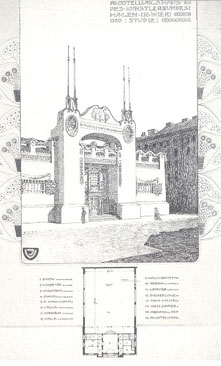
Fig. 51 Hagenbund exhibition hall, Vienna, remodeled
by Urban, 1901 , watercolor, 11 1/2 x 5 1/2 in.
Rare Book and Manuscript Library, Columbia University
To his interior designs which were
executed for private clients, Urban also designed several
other important public commissions, including the Strauss–Lanner
Room (fig. 11) in the Rathauskeller in Vienna's City
Hall on the Ringstrasse. Another important commission
was the redesign of a market hall into the exhibition
space for the Hagenbund (fig. 51), an artists' organization
that sought to rival the Secessionist group. This building
was completed in 1901; but with its four, squat towers,
stuccoed surface, and ornamental decorations, it could
not measure up to the consummate Secession building designed
almost four years earlier by Olbrich.
40
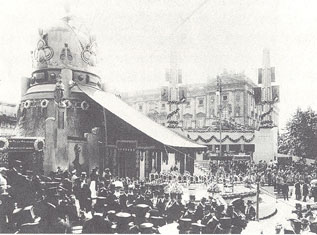
Fig. 52 Austrian Pavilion, Saint Louis World's Fair,
1904, photograph, 8x10 in.
Rare Book and Manuscript Library, Columbia University
Urban's early international triumphs
included the design of award–winning exhibitions
for the Austrian installation at the 1900 Paris Exposition
and at the Bavarian International Exposition of 1902.
He achieved a major success with his design for the interiors
of the Austrian Pavilion at the Saint Louis World's Fair
in 1904 (fig. 52),(where fairgoers could also see the
German Pavilion, installed under the direction of Josef
Maria Olbrich). These interiors were deeply indebted
to the stringent, geometric design vocabulary developed
by Hoffmann circa 1899–1900.7
Urban's last prominent Viennese commission
was his Kaiserpavilion of 1908 (fig. 53) which Franz
Josef II used as a viewing platform during the ceremonies
in celebration of his sixty years as emperor. Again,
Urban was indebted to an earlier work of Otto Wagner's,
his well–known Hofpavillion, the rail station built
at Schonbrunn palace in 1896–97.8 The
considerable cost overruns of Urban's temporary structure,
and the charges that he had favored his own friends in
the construction of this project, unfortunately compromised
his career in Vienna before the First World War.9
1912–1933: THE UNITED STATES
Although Urban moved to the United
States in 1912, he spent his first decade there primarily
working as a theatrical designer; his profile as an architect
in the United States would not emerge until the early
1920s. Essentially, the field of modernist architecture
in the United States was, at the end of the First World
War, in a brief period of relative stagnation. Apart
from the important earlier work of Frank Lloyd Wright,
design in the United States and its overall global influence
was focused in phenomena such as the process of standardization
and mechanization seen in the great automobile factories
of Detroit. These issues were also scientifically proposed
in the highly influential publications of Frederick Winslow
Taylor (1856–1915), which were read by many European
architects and engineers. A further contribution to international
modernism by the American design community was revealed
in the maturation of that engineering phenomenon most
fully associated with American urbanism, the skyscraper.
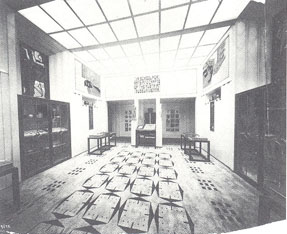
Fig. 53 Kaiserpavilion, Vienna, 1908, photograph, 8 x
10 in.
Rare Book and Manuscript Library, Columbia University
41
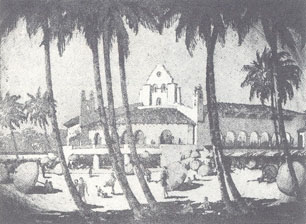
Fig. 54 Bath
and Tennis Club, Palm Beach, 1926, etching, 12 1/4
x 15 1/4 in.
Rare Book and Manuscript Library, Columbia University
Initially, and perhaps most importantly,
in the United States Urban benefited from a situation
completely opposite to what he had experienced in Vienna:
in the United States there were too few progressive architects
for the amount of work that was being commissioned. The
field of indigenous, progressive designers was relatively
uncrowded in the 1920s, and the number of European modernists
who would emigrate to the United States would remain
relatively small until the early 1930s.10 With
little competition in Manhattan, Urban was able to purvey
his work to the wealthiest group of Americans, many of
whom would have seen his designs at the Metropolitan
Opera and for the Ziegfeld Follies.
An examination of the architectural
work of Joseph Urban in the 1920s reveals his deep understanding
of client–architect relations and the prevailing
eclecticist tastes in the design community. At the same
time, it undermines the general perception among many
of these clients and some critics that he was part of
the architectural avant–garde. In little more than
a decade, Urban would work for such prominent Americans
as William Randolph Hearst, Otto Kahn, Marjorie Merriweather
Post, and Anthony
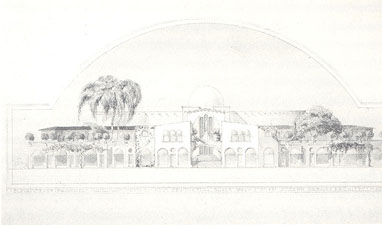
Fig. 55 Paramount
Theatre, Palm Beach, 1926, watercolor, 15x20 in.
Rare Book and Manuscript Library, Columbia University
Drexel Biddle, Jr. In addition to
his remarkable talent for social interaction – an
essential quality in serving the various needs of such
clientele –Urban utilized a wealth of aesthetic
expressions. Ranging from accomplished historicism to
designs based on progressive contemporaneous European
work, these projects were united by Urban's impressive
understanding of the aesthetic components of each style.
When Urban employed avant–garde
idioms, however, he often was little more than a copyist,
and many of his designs lacked the complex and technically
accomplished underpinnings that defined the groundbreaking
modernist works. Nevertheless, Urban's awareness of contemporaneous
European design concepts, and his brilliant recycling
of many of their creative elements, explains his ability
to appear as an innovator in a nation relatively unfamiliar
with his prototypes. Even if not entirely original, Urban's
work paved the way for the acceptance of many advanced
architectural ideas in the United States.
42
The impressive body of work that Urban
completed in Palm Beach in the second half of the 1920s
was deeply within the idiom of revivalist work that was
employed throughout the United States during the first
half of the twentieth century. He designed private homes,
shopping centers, private clubs, large commercial structures,
and churches, commissions created for an affluent market.
The internal plans, technical components, deployment
and mixing of ornament, and even the massing of these
buildings was often highly original and had little precedent
elsewhere. The fact that Urban could enter into this
world of architecture and design and produce such a remarkably
accomplished oeuvre in such a short period of time is
testimony to his talents and adaptability. His designs
in Palm Beach for the Bath and Tennis Club (fig. 54),
the Paramount Theatre (fig. 55), Anthony Biddle's residence
(fig. 56), and additions to Mrs. Post's monumental seasonal
home, Mar–a-Lago (fig. 3), and the Oasis Club bear
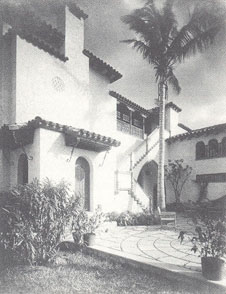
Fig. 56 Anthony
Biddle residence, Palm Beach, 1927, photograph, 10x8
in.
Rare Book and Manuscript Library, Columbia University
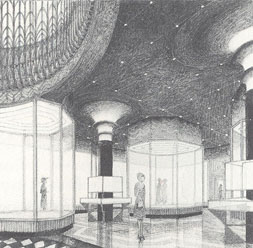
Fig. 57 Bedell
Store, showroom, 1928 (cat. 12c)
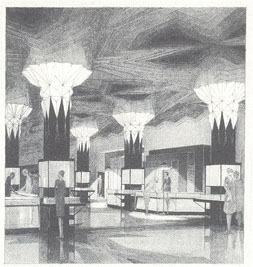
Fig. 58 Kaufmann Department Store, Pittsburgh, counter
area, 1928 (cat. 13)
43
favorable comparison to the work of
his contemporaries, such as Addison Mizner (1872–1933)
and Marion Sims Wyeth (1889–1982), working in the
same village.11 The deeply private world 'of
Palm Beach in the interwar era, however, did not allow
the public much exposure to Urban's work. But in the
metropolitan New York area his work was far more visible.
The International Magazine Building in New York (fig.
1), which Urban designed in 1927 for William Randolph
Hearst, looked back in many ways to pre– World War
I Vienna with its monumentality, towering columns, and
oversized decorative embellishments. The Bedell Store
in New York in 1928 (fig. 57) was a more obvious example
of design borrowing by Urban. The towering, fluted lighting
fixtures of the entryway of this women's fashion store
are quite similar to the interior lighting fixtures used
by Hans Poelzig in his
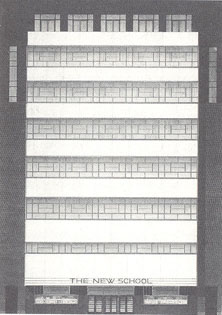
Fig. 59 The
New School for Social Research, elevation, 1 930
(cat. 1 9a)
outstanding Berlin theater, the Grosses
Schauspielhaus, completed in 1919 and refashioned from
a market hall for the renowned stage director Max Reinhardt.12 Urban
would also use a variation of these fixtures for his
renovation plans for the Kaufmann Department Store in
Pittsburgh (fig. 58).
Urban's most critically acclaimed
building in New York was the New School for Social Research,
completed in 1930 (fig. 59), and it typified his penchant
for borrowing and eclecticism. His deployment of stylistic
elements of the emerging International Style produced
an elegant facade. But the result had little to do with
this new movement's strong social purpose, which led
to a formal design vocabulary and an eschewing of ornamental
overlay. Urban was more eclectic in the aesthetic concepts
that he utilized for the building's interior. Elements
of the building's auditorium (fig. 60) were seemingly
borrowed from Walter Gropius's ingenious Total Theatre
designed for Erwin Piscator in 1927. Although never built,
Gropius's designs were known to many in the theater world,
as were the innovative concepts of Piscator, who advocated
a closer unity between stage and audience, a situation
reflected in Urban's egg–shaped plan which closely
paralleled Gropius's design. The double staircase in
the New School's library (fig. 61) is strongly reminiscent
of the double staircase used in the main rotunda of the
Stockholm Public Library, completed by Erik Gunnar Asplund
in 1 927 and well known in the international architectural
community.13 As much as it was praised, the
New School also had its detractors who criticized Urban's
lack of purity or originality.
By the time Urban emigrated to the
United States in 1912, he was nearly forty, an age when
few individuals dare to test their professional and social
skills within entirely new environments. Within a decade
of arriving opera, film, and stage, as well as freestanding
buildings and interior designs for extant structures.
Divorced from circumstances on the Continent and from
those colleagues who might have challenged his originality
44
Urban seems to have become something of a professional
sleuth, investigating the innovations of others. By the
end of the 1920s when his office was at its peak, he was
serving an enormous clientele with many different needs.
Ultimately it may be said that apart
from his facility to design in a variety of idioms which
often constituted antagonistic schools of thought, one
of the great accomplishments of Urban's life was that
he quickly came to understand the complexities of the
American marketplace which, in many ways, reflected the
diversity of the Vienna he had known in his early professional
life. Those lessons would enable him to become one of
the more successful and influential architect–designers
in the United States from the early 1920s until his death
in 1933.
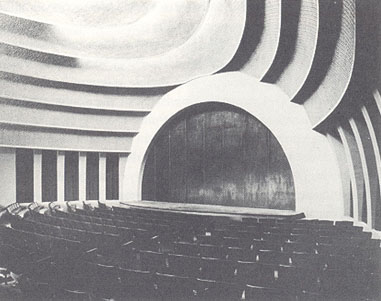
Fig. 60 The
New School for Social Research, auditorium, 1930
(cat. 19f)
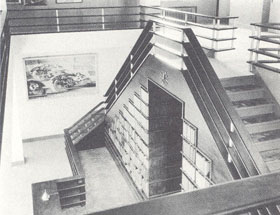
Fig. 61 The
New School for Social Research, stairs in library,
1930 (cat. 19d)
Derek E. Ostergard is a historian
of twentieth–century decorative arts and design
and is the associate director and founding dean of
the Bard Graduate Center for Studies in the Decorative
Arts.
NOTES
- The most comprehensive work on Joseph
Urban is Randolph Carter and Robert Reed Cole, Joseph
Urban: Architecture, Theatre, Opera, Film (New
York: Abbeville Press, 1992). This lavishly illustrated
work accords far more significance to the architectural
and design work of Urban than does the author of this
essay. The detailed chronology and abundant illustrations
have been used, with appreciation, in preparing this
essay.
- In 1859, Austria's centuries–long
participation in the governance of the Italian peninsula
ended, and when the Austrians lost to the Prussians
in 1866 at the battle of Sadowa, their pre–eminence
in pan-German affairs evaporated. Between the 1840s
and the 1860s, the Austrian government was forced to
capitulate to the Hungarians on many important issues
as well.
- The grunderzeit is a period
of time basically parallel to the Gilded Age in the
Unit ed States, to a portion of La Belle Epoque in
France, and to the Victorian and Edwardian eras in
Great Britain. For more information on late nineteenth– and
early twentieth–century
45
Vienna, consult the finest work on the period, Carl
E. Schorske, Fin–de-Siecle Vienna: Politics
and Culture (New York: Knopf, 1979). In addition,
another noteworthy work on Vienna at this time is Stefan
Zweig's World of Yesterday: An Autobiography of
Stefan Zweig (New York: Viking, 1943).
- Olbrich's role in the Viennese design
community would be very brief, as he would be hired
to head an important design colony in Darmstadt, funded
by Grand Duke Ernst Ludwig, a grandson of Queen Victoria
and the brother of Empress Alexandria of Russia. Olbrich
would move there in 1899, and afterwards become known
as the most influential architect–designer in
the German-speaking world by the time of his death
in 1908. For further information, see J.M. Olbrich,
Architektur (Berlin: E. Wasmuth, 1901–14),
issued in thirty parts.
- Hoffmann has been the subject of
many books. The most comprehensive examination of his
architectural commissions is Eduard F. Sekler's Josef
Hoffmann: The Architectural Work (Princeton: Princeton
University Press, 1985). For a review of his designs
for objects, see Peter Noever, ed., Josef Hoffmann
Designs (Munich: Prestel, 1992).
- It is interesting to note that the
principal architects and designers who worked in Vienna
in the second half of the nineteenth century and who
contributed to the historicist appearance of the city
had all died by the decade of the 1890s, the decade
when Urban came of age: Eduard van der Null (1812–1868),
August Siccard von Siccardsburg (1813–1868),
Gottfried Semper (1803–1879), Heinrich von Ferstel
(1828- 1883), Theophil von Hansen (1813–1891),
Friedrich von Schmidt (1825–1891), and Karl von
Hasenauer (1833–1894). The void left by their
deaths was quickly and brilliantly filled by Otto Wagner,
whose skills as architect, designer, author, and teacher
placed him in an open field with few challengers. This
situation was particularly difficult, however, for
the group of younger architects emerging just before
the turn of the century. Some, like Josef Maria Olbrich,
took advantage of opportunities else where, while others,
like Josef Hoffmann, filled two niches in Vienna: as
product designer and as residential architect for wealthy
and progressively minded individuals living in the
Austro–Hungarian empire. Wagner's own studio
was famous as a center for the cultivation of forward–thinking
young architects and designers. Apart from Olbrich
and Hoffmann, other individuals (amongst many) who
trained in Wagner's office included Leopold Bauer (1872–1938),
Jan Kotera (1871-1923), and Joze Plecnik (1872–1957),
all of whom were born within a year of Urban. The overall
domination of the design "market" by one giant,
who naturally looked out for those individuals coming
out of his office, certainly must have made professional
advancement difficult for a young designer like Urban.
For further information on the highly active atelier
of Otto Wagner, see Marco Pozzetto, Die Schule
Otto Wagners: 1894–1912 (Vienna: Anton Schroll,
1980).
- This vocabulary was already closely
associated with Hoffmann's career by 1903 when he began
work on the Purkersdorf Sanitarium, his magisterial
gesamtkunstwerk based on this approach to design. For
information on this pavilion and photographs of its
exterior and interior, see Sekler, Josef Hoffmann:
Architectural Work.
- For images of this station, see
Harry Francis Mallgrave, ed., Otto Wagner: Reflections
on the Raiment of Modernity (Santa Monica, CA:
Getty Center for the History of Art and the Humanities,
1993) 32–33.
- This theory is advanced by Carter
and Cole in Joseph Urban, 39–42.
- Some of the foreign–born designers
working in the United States during the final decade
of Urban's life were Rudolf Schindler (1887–1953)
and Richard Neutra (1892–1970): both were Austrians
who chose to work in California. Other significant
European architects who would come over after Urban's
death in 1933 were Walter Gropius (1883–1969),
Ludwig Mies van der Rohe (1886-1969), and Marcel Breuer
(1902–1981).
- For more information on visual components
of the houses of Palm Beach, see Roberto Schezen, Palm
Beach Houses (New York: Rizzoli, 1991).
- The interiors were well known through
published illustrations throughout the decade. For
images of these fixtures, see Julius Posener, Hans
Poelzig: Reflections on His Life and Work (New
York: Architectural History Foundation, 1922) 124–25.
- For an image of this room, see Claes
Caldenby and Olof Hultin, Asplund (New York:
Rizzoli, 1986)101.
46
[47]
JOSEPH
URBAN
AND THE BIRTH OF AMERICAN
FILM DESIGN
MATTHEW WILSON SMITH
ON 19 FEBRUARY 1920, Joseph Urban
signed a contract to serve as the art designer for William
Randolph Hearst's fledgling film venture, Cosmopolitan
Productions. By hiring Urban, the newspaper magnate was
gaining one of the most highly regarded set and lighting
designers in the business, a designer equally at home
in the Metropolitan Opera and the Ziegfeld Follies.
During the next several years of his career, largely
with Cosmopolitan, Urban would serve as art designer
for some thirty pictures. Although he brought a wealth
of experience to the new medium, ranging from his training
in stage design to architecture to interior design to
illustration, he repeatedly argued against subordinating
film to another art form. Indeed, at a time when film
was widely understood as a lesser cousin of the stage,
Urban insisted that the new medium was a genuine art
with distinct aesthetic criteria. Through such visionary
encouragement, as well as practical contributions to
set and lighting design, Urban helped to raise American
cinema from its adolescence of the first two decades
of the century to its adulthood of the thirties and forties.
The success of Urban's contributions
to American film is particularly striking given the culture
of the early silents. Before Urban came on the scene,
the design of the earliest films was a rudimentary affair:
the sets were simple, reusable flats before which a fixed
camera was placed. Innovation, when it came, progressed
slowly. Toward the end of the first decade of the century
the reusable flats began to be placed at right angles
to one another in L or U shapes, with the effect of adding
depth and a greater degree of realism. This depth in
turn freed up the camera, which could now explore angles
and shadows within a three–dimensional environment.
Outdoor settings and multiple rooms came to play a role
in the early 1910s, such that set windows looked out
over genuine vistas and interior doors revealed offstage
chambers. Such crucial early steps prepared the way for
two magnificent leaps in the mid–teens: Giovanni
Pastrone's Italian extravaganza Cabiria (1914)
and D. W. Griffith's American retort, Intolerance (1916).
These films offered unprecedented spectacle: full–scale
recreations of ancient Carthage and Babylon, sets of
the Temple of Moloch and the King of Babylon's palace,
chariots racing on city ramparts and the eruption of
Mount Vesuvius. Together, Cabiria and Intolerance brought
a level of visual wonder to silent film that would emphatically
signal an end to the era of the simple painted flat.
Finally, toward the late teens, studios began to rely
almost entirely on artificial lighting for their interior
scenes, thus increasing the demand for technical expertise
in artistic design. This increased demand, together with
the high standards suddenly set by pictures such as Cabiria and Intolerance,
marked the beginning of art direction in American film.
48
The history of early art direction
in American film largely consists of the contributions
of four gifted designers: Wilfred Buckland, Robert Brunton,
Hugo Ballin, and Joseph Urban. Formerly the technical
director for David Belasco, Wilfred Buckland became the
nation's first real art director when he joined the Famous
Players–Lasky studio in 1914. The rich settings
and dramatic lighting of Buckland's style were received
enthusiastically by a public becoming increasingly familiar
with film and thus more receptive to innovation. "Here
were faces, groups, and interiors" wrote Photoplay on
Buckland's design, "lit by a warm glow of light,
clear and yet full of the modeling of delicate shadows,
and dramatized by discriminating concentration from one
general source. At one point a touch of 'back lighting'
shot across the scene, picked up a curve of the throat,
a twist of bright hair, or a fold of lace for a glowing,
glistening high–light."1
Following in Buckland's footsteps,
Robert Brunton is credited with introducing a measure
of restraint into the increasingly lavish set designs
of the late teens and early twenties. His more muted
style was largely achieved through the use of heavy shadow,
which blotted out all but the most important set features
and directed attention to the characters. Like Brunton,
Ballin – who was also a trained architect, an accomplished
painter, and a sometime film director – stressed
scenic restraint and emphasized the characters over the
set. To an unprecedented degree, Ballin was also a full
member of the film production staff, participating in
production decisions from the outset and standing beside
the director throughout the shoot. It is with Ballin
that the cinema art director fully emerged as a fine
artist, jack–of-all-trades, and businessman: a combination
of roles ideally suited to the versatile Joseph Urban.
"You probably know that Mr. Urban
is today the most distinguished master of environment,
light and color that we Anglo–Saxons have in the
theatre," Photoplay reminded its readers
in an article celebrating Urban's entrance into the cinema.2 Urban
was curtailing his architectural and stage–design
career (with the exception of his work for the Metropolitan
Opera) at the behest of Hearst, who had just founded
Cosmopolitan Productions in New York's East Harlem. The
mission of Cosmopolitan was straightforward: to make
popular yet artistic movies with high production values,
and by so doing to offer the public an alternative to
the cheap slapstick reels that had become so ubiquitous
in the industry. The movies would cost up to two dollars,
but the extra expense, Hearst hoped, would be worth it.
The public unfortunately, decided otherwise. "The
whole trouble was that W. R. was ahead of the times," remembered
the Cosmopolitan general manager George d'Utassy many
years later. "He made 'super' pictures several years
too soon."3 Although the run of Cosmopolitan
Productions as an independent business was brief, it
would produce a number of superior films and one genuine
silent film star: Marion Davies, an actress whose genuine
talents have been overshadowed by her role as Hearst's
Trilby–esque mistress. The other star of Cosmopolitan
was Urban himself, who often earned positive reviews
for the studio's films even when the plot and acting
were not up to the high standard of Urban's designs.4 Hearst
fully appreciated Urban's talents and, when the artist's
contract was running out, used every inducement to get
Urban to stay.5
After spending a brief period as an
observer at Cosmopolitan, Urban plunged into his work
with characteristic enthusiasm. One of his first acts
was to redesign the lighting system at the studio. In
an era before color film, Urban argued that "with
proper backgrounds, furniture that belongs to those backgrounds
and decorations that suggest color, the mind of the spectator
can be made to think in colors even when they are not
shown."6 To this end, Urban composed black–and-white "color
charts" to test the ways in which different colors
and textures appeared on black–and-white stills,
as well as the way in which such stills may or may not
suggest color and texture. Lights, he argued, should
come from discrete sources (rather than be washed over
the scene with floodlamps from the front) and could
49
be used creatively to suggest atmosphere and character.
Although some of these artistic innovations – the
use of "color charts," for example – were
adopted, many of Urban's designs met with resistance, and
the first year that Urban spent at the studio was a difficult
one.
Urban's frustration during his first
year at Cosmopolitan is evident from the notes that he
wrote on the backs of several film stills. One still
of the Marion Davies feature The Restless Sex (1920),
for instance, shows an elegantly composed interior (fig.
62). The room is dark, with a single light source from
a high window casting long shadows across the scene.
Partially illuminated by the window, a sculptor sits
on a stool, adopting the anguished attitude of his own,
Rodin–like creation. "As lit by Urban" reads
the note on the back of the photograph.7 The
second picture, however, is a case study in the effect
of poor lighting: the same scene is here lit diffusely,
the light source ambiguous, the shadows muted, the mood
vague (fig. 63). "As re–lit by director," reads
Urban's note. Similar complaints can be found in Urban's
notes to subsequent films, but the situation probably
reached a nadir with a forgotten (and by all accounts
forgettable)
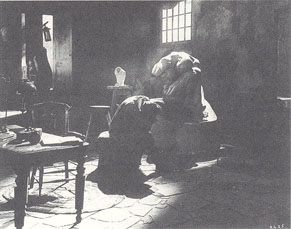
Fig. 62 The
Restless Sex, Oswald's studio, with lighting
by Urban, 1920
work entitled Heliotrope.
As usual, the problems began with the director's insistence
on doing his own lighting. On the back of a still of
a fountain in a courtyard (fig. 64), Urban wrote:
See wrong direction
of light and shadows on
1. – Gate to the left
2. – Madonna
3. – Fountain
and flatness on everything else.
As lit by director.
An accompanying photograph, with Urban's
lighting, shows the same scene to dramatically different
effect (fig. 65).
But Urban's troubles with Heliotrope went
beyond mere bad lighting; his set designs, too, were
altered or eliminated. The dining room that Urban designed
for the film would have been – had it been used
- the first modern interior in American movies (fig.
66). Distinctive features of the room included a Werkstatte–inspired
use of strict geometric figures, with white rectangles
on the ceiling and in archways and interlocking off–white
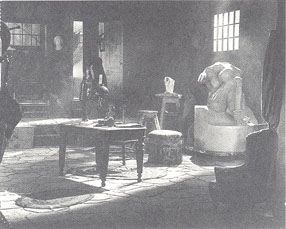
Fig. 63 The
Restless Sex, Oswald's studio, with lighting
by the director, 1920
50
circles on the walls above the doorframes.
The bar area, which echoes Urban's design of the bar
in his own dining room in Vienna,8 is painted
white with dark trim to stress the geometry of the piece
and to harmonize with the wall and ceiling. Urban's startlingly
modern interior never made the screen, however; it was
replaced by a more traditional dining–room set
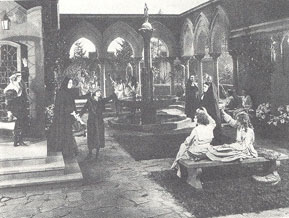
Fig. 64 Heliotrope,
convent garden, with lighting by the director, 1920
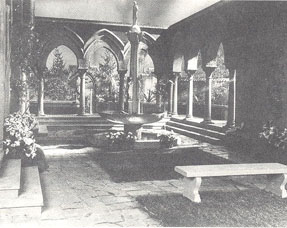
Fig. 65 Heliotrope,
convent garden, with lighting by Urban, 1920
preferred by the director, a Cosmopolitan
regular named George D. Baker.
Urban's set for Heliotrope is
also interesting in that it demonstrates his intention,
anticipated only by Ballin in American film, to design
an environment around a close reading of a character.
Urban's explanation for his modern interior is laid out
in an extensive note, written in slightly stilted English,
on the back of a photograph of a conservatory garden
in the same summer home:
My idea was that the
man growing rich in last few years being an honorable
businessman with modern and new ideas, a very sympathetic
figure in the picture, took naturally a modern architect
to fix the interiors in his summer home and the architect
would show as much wood as he can for interiors, in this
case because he builds for a man which loves wood.
The degree of thought put into the
design of the businessman's dining room is unusual; Urban
not only looked beyond the precise stipulations of the
script in order to imagine the sort of interior that
the character might inhabit but also brought his expertise
in modern architecture into play.
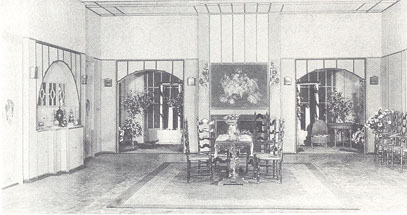
Fig. 66. Heliotrope,
design for dining room, 1920
51
This sort of close attention to the
entire mise en scène of a production was a distinctive
feature of Urban's approach. "[Urban] considers it
his business to write the drama of scenery, to reflect
the situations and characters in the houses and homes
he builds for them," wrote the Evening Post in
1920.
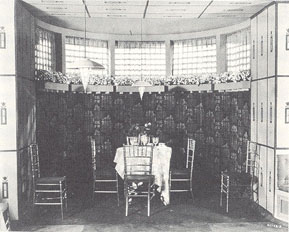
Fig. 67 Enchantment,
design for dining alcove of a tearoom, 1921
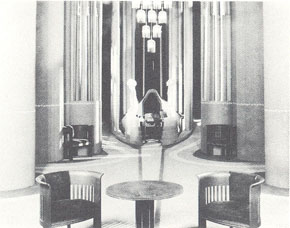
Fig. 68 The
Young Diana, Dimitrius' study, 1922 (cat. 77b)
Pantomime, effective as it is in the
expression of emotion, must always, in Mr. Urban's mind,
be supplemented by scenery. To do this, the mind of the
artist must grasp, not the dramatic struggle of one character
but of all characters, and not alone architectural verisimilitude
but atmosphere and mood. Needless to say, he must take
infinite pains with manuscript and people bringing to
bear upon them his interpretive genius.
"I want," said Mr. Urban, "to
make pictures that are moving compositions in the same
sense that a great painting is an immobile composition.
At any point in a photo play, a photographic 'still'
should reveal people and scenery in perfect artistic
coordination."9
While hardly a radical notion among
knowledgeable theater designers in the early twentieth
century, Urban's desire to create a "perfect artistic
coordination" between people and scenery was something
of a revelation to the world of the American silents.
Like many early art designers, Urban
took special pride in the historical accuracy of his
designs. This pride led to frequent battles with Hearst,
an enthusiastic collector of real and fake antiques,
which he liked to see showcased in his movies. It was
a situation that was destined to lead to conflict with
the exacting Urban, and the altercations between producer
and art director on the matter were laid to rest only
when Hearst backed up a truck loaded with his most recent
purchases – a virtual armory of medieval armor and
assorted bronzes – accompanied by a note telling
Urban to "put them on the set." "We heard
his wrath resound throughout the whole building," recalled
a former assistant many years later, whereupon Urban
packed his bags and took a ship back to Vienna to visit
his mother, not even bothering to resign.10 The
tactic worked: Hearst eventually had to send a wire with
a pay raise to Urban's ship in order to get the designer
back. Although it was the last conflict that the designer
would have with Hearst over the issue, it was hardly
the end of Urban's trials. In a subsequent incident,
during production of the Spanish costume drama The
World and His Wife, a carpenter told Urban to base
his set designs on a
52
series of vaguely Spanish picture postcards that he had
found, as well as a photograph of a house in southern Spain.
It was left to Urban to argue for his own designs against
those of the carpenter, during which Urban was compelled
to explain to the director that the carpenter's photograph
was not of Spanish architecture at all but was, rather,
a French chateau built in Andalusia by a war profiteer.
The incident was relatively trivial
in itself but highlighted the fact that Urban's talents
and expertise were regularly being thwarted by the studio.
This time, Cosmopolitan Productions responded to the
problem more systematically. An associate producer named
W. Sistrom composed an internal letter to the studio,
discussed Urban's complaints (with particular reference
to the incident of the "picture postcards"),
and argued for fundamental changes in film production. "What
is a director in our scheme of things has been frequently
discussed but never settled," the letter begins.
Now it has got to be
settled because Urban is extremely unhappy under present
conditions and unless something is done we are going
to miss the opportunity to be THE concern that gets the
credit for the tremendously important contribution to
screen technique that Urban is going to make – either
now or later with us or with someone else.11
The letter goes on to detail two different
methods of film production: the "organization method," in
which a single, in–house individual directs the
show and generally guides the whole process; and the "director
method," in which the studio hires an outside director
to do the job. The best solution, Sistrom continued,
would be a "rational combination of the good points
of both methods." Importantly, this combination would
give greater weight to the art designer, who would have
his designs finished and approved by the studio before
an outside director was even hired. This change, Sistrom
concluded, should alleviate Urban's "trouble," which "arises
from the fact that he does not come in contact with the
production until it is 'set' in the director's mind."
Although the organizational changes
at Cosmopolitan were ultimately not as fundamental as
Sistrom had recommended, circumstances nevertheless shifted
dramatically for Urban by early 1921. Inside of the
Cup, released at the beginning of 1921, was a cause
of frustration,12 but his work thereafter
started to reach the screen unimpeded. Thus Urban was
able to realize the modern style of Heliotrope in
films like Enchantment (1921) and The Young
Diana (1922). Finally making a virtue of his talents,
the publicity department promised that the settings for Enchantment would
be "ultramodern in every sense of the word,"13 and Enchantment became,
indeed, the first American movie to feature modern interior
design. Of numerous remarkable set pieces for the film,
a dining alcove of a tearoom stands out in particular
(fig. 67). The design successfully contrasts the geometric
forms influenced by the Wiener Werkstatte with delicately
patterned wallpaper reminiscent of William Morris's work.
As usual, Urban's lighting is well considered: hanging
fixtures (also of Werkstatte style) illuminate the room
from above, while sunlight pours down on the scene from
clerestory windows over flower boxes. Urban's experiments
in modern design continued in The Young Diana,
a movie that Photoplay called "a style show,
perhaps, but not a good motion picture" yet singled
out for its "beautiful sets."14 Like
many films that Urban worked on, it retains interest
largely due to his designs, perhaps the best of which
is a sophisticated, hypermodern office with semicircular
chairs fitted into pillars and a central desk framed
by art deco sculptures (fig. 68).
It would be a mistake, however, to
limit Urban's influence at Cosmopolitan – and on
American movie culture generally – to his stage
and lighting innovations. For, in a less tangible but
no less important way, he was also bringing a sense of
European high culture to the still marginal medium of
American silent films. "I sent my whole staff to
see 'Dr. Caligari,'" he remarked in the early twenties,
53
and then I called them
all together – the directors, the technical experts
and the stage hands – and I gave them a short lecture
about it, telling them just what it meant to me and what
vistas it seemed to open up for the profession in which
they were engaged. You couldn't hear a restless motion
in the course of the talk. No one lighted a cigaret.
And when it was over, the whole crowd went out in twos
and threes and more, earnestly discussing the problems
and questions of art, probably for the first time in
their lives.15
By introducing American directors
and technicians to German expressionism, Urban was helping
to pave the way for a movement that would reshape the
long, dark shadows of Murnau into a distinctly American
style. Combined with many of his own designs – from
the rejected early lighting of The Restless Sex to
the moody shadows of features like Bride's Play, Enchantment,
and The Young Diana – Urban's studio lectures
on Caligari suggest that he can be seen as a
link between German expressionism and American film noir.
In addition, Urban was introducing the idea, more novel
in America than in Germany, that film was a genuine art
form, with distinct aesthetic criteria. "So far," Urban
wrote,
we have borrowed more
or less from the stage and have overlooked the fact that
spoken words, color, perspective and spatial relations
are missing. We must develop the motion picture as an
independent artistic expression, so individual and self–sufficient
that we shall not feel the need of what we cannot have.
Until this is done, all our painstaking effort is wasted
by trying to build on an imperfect foundation.16
In his lectures as well as his designs,
Urban was helping to advance the notion that American
film was not only entertainment, not only business, but
an "independent artistic expression." As such,
he was at the forefront of the move in American cinema
away from stage conventions and toward the unique demands
of the screen.
Urban designed his last film for Cosmopolitan
in 1925, after which he established an architectural
studio in New York (paid for with earnings from his film
work) and continued designing sets for the Metropolitan
Opera and other companies. While he would return to film
with a few projects for Fox in the early thirties, his
major innovations were largely behind him; the Werkstatte–influenced
designs that he offered for the Fox productions seem
almost tame beside the enthusiasm for art deco that had
since swept the nation. Urban's contribution to film
design could be seen, however, in the more sophisticated
sense of design inherited and promoted by art directors
who came after him. Urban noted this development himself
when, looking back on the course of American film from
the standpoint of 1930, he wrote with pride that "directors
have more and more turned their attention to the proper
lighting of scenes, to an expressive location of the
camera eye in the scene picture and to the development
of new beauties in the art of photography."17 Characteristically
unwilling to rest on his laurels, however, he criticized
directors for their unwillingness to take creative risks
and looked forward to the day when "the highly individual
picture" might be "dominated by one creative
will."18 As a plea for cinematic auteurism,
Urban's dream came some twenty years too soon. Urban,
as usual, was ahead of his time.
Matthew Wilson Smith is a scholar
who writes on aspects of theater, film, and popular
culture. He is currently working on a project on Bayreuth
and Disneyland.
54
NOTES
All photographs reproduced courtesy
Rare Book and Manuscript Library, Columbia University.
- Photoplay (January 1921):
74.
- Photoplay (October 1920):
32.
- Quoted in John K. Winkler, William
Randolph Hearst: A New Appraisal (New York:
Hastings House, 1955) 227.
- A pattern of criticism – lack
of enthusiasm for the film as a whole, high praise
for the set and costumes – emerges from reviews
for Urban's Cosmopolitan pictures. A New York Times review
of the Marion Davies costume drama When Knighthood
Was in Flower (1922) is typical: "though you
may have doubted about the authenticity of the story,
you are bound to be impressed with the authenticity
of the settings. Surely Joseph Urban, who is responsible
for them, has been true as well as magnificent. His
scenes are splendid or simple, according to the character
they should have, and, while they often impress the
eye by their size and finished composition, they never
seem present merely to be impressive. They are part
of the story and ultimately successful in enriching
it" ("The Screen," New York Times,
15 September 1922).
- Not least among the projects that
Hearst hoped to convince Urban to work on was Hearst's
famous "castle" at San Simeon. Urban, generally
diplomatic with Hearst, privately referred to the place
as a "monstrosity" and a "constipated cathedral," though
he enjoyed the beauty of the surrounding mountains.
In an attempt to convince Urban to stay – for
the sake of the castle as well as the movies – Hearst
offered the artist various "extras," such as
an architectural contract for a new office building
in San Francisco. Urban, eager to establish an architectural
firm of his own in New York, repeatedly and politely
refused. For an excellent survey of the often complicated
relations with Hearst, see Randolph Carter and Robert
Reed Cole, Joseph Urban: Architecture, Theatre,
Opera, Film (New York: Abbeville Press, 1992),
145–68.
- Sunday Journal (3 October
1920).
- All film stills referred to here
(and their accompanying notes) are located in the Joseph
Urban Collection, Rare Book and Manuscript Library,
Columbia University (hereafter JUG).
- For a picture of the dining room
in Urban's Vienna apartment, see The Upholsterer 65
(September 1920): 70.
- Evening Post (3 July 1920).
- New Yorker (14 September
1940): 80.
- Letter from W. Sistrom to an unknown
recipient, undated (1921?), JUC.
- The back of one of Urban's still
reads simply: "a sample of how big and serious
work is ruined through lighting and photography" (JUC).
- Quoted in Donald Albrecht, Designing
Dreams: Modern Architecture in the Movies (New
York: Harper and Row with the Museum of Modern Art,
1986) 40.
- Quoted in Howard Mandlebaum and
Eric Myers, Screen Deco (New York: St. Martin's
Press, 1985)140.
- Joseph Urban, typed manuscript with
handwritten date "1921 or 1922" (JUC).
- Ibid.
- Urban, "The Cinema Designer
Confronts Sounds," in Oliver M. Sayler, ed., Revolt
in the Arts (New York: Brentano's, 1930) 241 .
- Ibid., 243.
55
THE
JOSEPH URBAN COLLECTION
AN OVERVIEW
ON 29 SEPTEMBER 1958, the president
of Columbia University, Grayson Kirk, on behalf of the
Brander Matthews Dramatic Museum, formally accepted the
gift of the Joseph Urban archive from Urban's widow,
Mary Porter Beegle Urban. She subsequently noted
that she chose Columbia because the late Brander Matthews,
who had been a professor of dramatic literature and the
founder of the museum, had admired her husband's work. Furthermore,
she had personal ties to the university, having been
the director of physical training, pageantry, drama and
the dance at Barnard College before her marriage to Urban
in 1919.
Now part of the Rare Book and Manuscript
Library, the collection is the largest single holding
of Urban's work. It covers a prolific and eclectic career
which began in fin–de-siecle Vienna and culminated
in New York in the twenties and thirties. When Urban
died in 1933, he had long been a household name, known
not only for his buildings and stage settings but also
for his designs of exhibitions, interiors, automobiles,
furniture, store windows, roof gardens, and ballrooms.
The Joseph Urban Collection, extending
more than 135 linear feet, includes approximately 700
watercolor drawings, as well as ground plans, elevations,
scrapbooks, and photographs. In addition, there are 328
set models, some of which have been restored for this
exhibition. (Many of the models are extremely fragile
owing to the nature of the material used in their construction
and currently await conservation treatment.) The collection,
excluding the set models, has recently been reprocessed,
rehoused, and described at item level with the help of
grants from the National Endowment for the Humanities
and the Gladys Krieble Delmas Foundation. When acquired,
each project was stored in an envelope or file and arranged
alphabetically within three groups – Vienna, Boston,
and New York – the three cities where Urban worked.
Those groups have been maintained, with materials arranged
chronologically within them. The New York material is
further divided into five categories: theater, Ziegfeld
Follies, Metropolitan Opera, film, and architecture
and design.
The Vienna files contain sketches,
plans, and photographs for residences, rooms, restaurants,
and monuments. There are examples of book illustrations,
interiors, and set designs that Urban created in collaboration
with his first wife's brother, the artist Heinrich Lefler.
The two together founded the Hagenbund Society, a group
of artists espousing modernist tendencies. The collection
contains catalogues for Hagenbund exhibitions from 1902
to 1910 which provide ample evidence of Urban's skill
as an exhibition designer.
Urban immigrated to America in 1912
and found employment as the scene designer for the Boston
Opera Company (fig. 70). He was provided with a studio
and permitted to bring over his scene painters from Austria.
With their evocation of mood through creative use of
color, Urban's designs for the Boston Opera were a sensation.
His efforts are represented in the collection by watercolor
drawings, plans, photographs, and production
56
records (light plots, cast lists, set lists, prop lists,
and line drops) for productions such as Les Contes
d'Hoffmann (1912), Louise (1912), I Gioelli
delta Madonna (1913), and Die Meistersinger von
Nurnberg (1914).
The Boston Opera Company went bankrupt
in 1914, and Urban soon began designing sets in New York.
The collection is especially rich in his theater and
opera works, and the material clearly reveals his pattern
of working. He would study a play or libretto, discuss
it with the director and producer, and then paint in
watercolor a scale drawing of a scene. His artisans would
create the ground plan from the sketches, and a set model
would be built and painted. Urban would check the model
and make changes, if needed. Then the scene painters
would place a large canvas on the floor and work on it
horizontally, rather than vertically as was usually the
case (fig. 69). Reference material, scripts, watercolor
drawings, pencil sketches, technical drawings, photographs,
and programs document this procedure.
Productions represented in the collection
include the Ziegfeld Follies and the Midnight
Frolics, as well as Ziegfeld's hit shows Sally (1921), Show
Boat (1927), Whoopee (1928), and Flying
High (1930). Some notable non–Ziegfeld productions
are The Garden of Paradise (1914), which brought
Urban to Ziegfeld's attention; Caliban of the Yellow
Sands (1916), a pageant held in Lewisohn Stadium
at New York's City College to celebrate the three hundredth
anniversary of Shakespeare's death; and Nju (1917),
Urban's attempt, with the director Richard Ordinski and
the critic Kenneth Macgowan, to present drama without
commercial compromise. Also included are all the designs
Urban executed for the Metropolitan Opera Company from
1917 through 1933, among them Faust (1917), Cost
fan tutte (1922), Falstaff(1925), Jonny
spielt auf (1929), and Elektra (1932).
When William Randolph Hearst engaged
him in 1919 as art director for his movie studio, Cosmopolitan
Productions, Urban became one of the first artists to
design for the new medium of film. Urban was to work
for
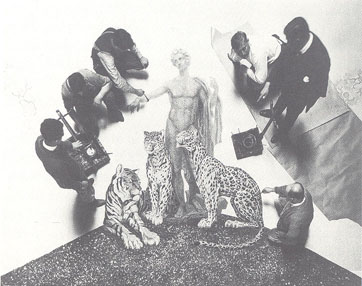
Fig. 69 Painting a mural for the Tiger Room at the Sherman
Hotel, Chicago, 1920, photograph. 8x10in.
Rare Book and Manuscript Library, Columbia University.
Hearst until 1925. The collection
contains scrapbooks with photographs of scenes from all
of the films, scrapbooks of reference material, and a
few watercolors. Of interest is a color key that shows
how various colors appeared when photographed in black
and white, indicating how Urban used color for depth
and texture even when it was impossible to see its hue.
Urban's battles for artistic control with the film director
probably generated a letter dated January 1920 that already,
early in the history of film, shows that filmmakers were
grappling with the question of who is more important
to the creation of a film, the director or the studio.
Although the collection contains many
watercolor renderings and photographs of Urban's architectural
and design projects, there are few specifications, plans,
or other background material. There are, however, nine
schemes that Urban designed for a proposed Metropolitan
Opera House (1926–27), which was never built. And
there is a scrapbook that
57
reveals Urban's attempt, in 1922, to help Austrian artists,
impoverished in the aftermath of World War I, by selling
their crafts in a Wiener Werkstatte store that he opened
on Fifth Avenue. In addition, the whole of Urban's career
in New York, dating from 1914 to his death in 1933, is
thoroughly documented in scrapbooks of newspaper clippings.
While the original scrapbooks have deteriorated beyond
use, the information has been preserved and is available
on microfilm.
Additional papers were recently discovered
in Mrs. Urban's former home and donated to Columbia University
in 1996. These papers contain material intended for a
biography, letters and telegrams from Urban in Hollywood
to his wife in New York, and a few telegrams from Florenz
Ziegfeld. Biographical material contributed by Urban's
daughter Gretl, and by his biographers Randolph Carter
and Robert Cole, has also further enriched the collection.
The Urban collection is one of the
most popular and heavily used collections in the Rare
Book and Manuscript Library. During the past decade it
has been cited in a number of significant books. Among
them are: Robert Reed Cole and Randolph Carter, Joseph
Urban: Architecture, Theatre, Opera, Film (New York:
Abbeville, 1992); Richard E. and Paulette Ziegfeld, The
Ziegfeld Touch: The Life and Times of Florenz Ziegfeld,
Jr. (New York: Harry N. Abrams, 1992); William Taylor, Inventing
Times Square (New York: Russell Sage Foundation,
1991); John Dizikes, Opera in America (New Haven:
Yale University Press, 1993); Robert A. M. Stern, New
York 1930 (New York: Rizzoli International, 1986);
Mary C. Henderson, The New Amsterdam: The Biography
of a Broadway Theatre (New York: Hyperion, 1997);
Markus Kristan, Joseph Urban: die wiener Jahre des
Jugendstilarchitekten und Illustrators, 1872–1911 (Vienna:
Bohlau, 2000). Works have been lent to numerous exhibitions,
including those at the Kunsthalle Wien (1995), the Smithsonian
Institution (1997), the Metropolitan Opera Company (1997),
the Carnegie Museum of Art in Pittsburgh (1999), the
Whitney Museum of American Art (1999), and the Wolfsonian
Museum in Miami Beach (2000). Students and scholars have
recently used the Joseph Urban Collection for research
on topics that include architecture, theater, set design,
film design, interior design, musical comedies, the Ziegfeld
Follies, New York nightclubs, Urban's work in Pittsburgh,
Austrian architects, Urban's work in Austria, the Wiener
Werkstatte, the Reinhardt Theatre, the New Stagecraft,
William Randolph Hearst, and Florenz Ziegfeld.
Gwynedd Cannan
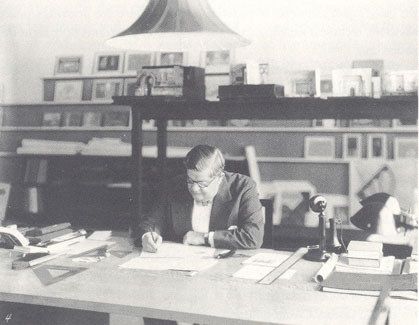
Fig. 70 Urban in Boston studio, 1916, photograph, 8 x
10 in.
Rare Book and Manuscript Library, Columbia University
58
CHECKLIST
OF THE EXHIBITION
ALL WORKS ARE FROM THE JOSEPH URBAN
COLLECTION WHICH IS PART OF THE BRANDER MATTHEWS DRAMATIC
MUSEUM COLLECTION IN THE RARE BOOK AND MANUSCRIPT LIBRARY
AT COLUMBIA UNIVERSITY.
Dimensions are in inches, height before
width before depth. Productions at the Boston Opera are
designated (B), at the Metropolitan Opera (M), and for
the Ziegfeld Follies (Z).
ARCHITECTURE AND DESIGN
- Kaiser Bridge, Vienna, elevation,
1898
watercolor, 11 3/8 x 8 in.
- Chronika der drei Schwestern, underwater
castle, 1899
watercolor, 11 1/8 x 9 in., fig. 41
- Esterhazy Castle, St. Abraham,
Hungary, interior, 1899
watercolor, 10 5/8 x 9 3/8 in. (irreg.), fig. 9
- Rathauskeller, Vienna, 1899
a. Strauss–Lanner Room, watercolor, 11 x 8 1/2
in., fig. 11
b. Strauss–Lanner Room, reproduction of photograph,
12 x 9 1/2 in.
c. Large dining room, reproduction of photograph, 9
1/2 x 12 in., fig. 10
- Goltz Villa, Vienna, 1902
a. Plan and view of interior, pen and ink, 9 1/2 x
7 3/8 in., fig. 5
b. Game and music rooms, watercolor, 9 1/2 x 7 3/4
in., fig. 6
- Redlich Villa, Vienna, elevation
of Else Redlich's bedroom, 1907
watercolor, 7 3/4 x 11 1/2 in., fig. 32
- Andersen: Zwolf Marchen, retold
by Hugo Salus
illustrated by Heinrich Lefler und Joseph Urban, Vienna:
M. Munk, 1911
- Metropolitan Opera House (proposal), New
York, 1926–27
a. Facade: early study, reproduction of pencil drawing,
13 1/8 x 10 1/8 in., fig. 17
b. Scheme IX, longitudinal section, watercolor, 17
3/4 x 27 1/2 in.
c. Lobby, etching, 11 x 14 7/8 in.
d. Proscenium, watercolor, 29 7/8 x 20 in., fig. 18
- Ziegfeld Theatre, New York,
1926–27
a. Facade, ink and wash, 22 1/2 x 18 3/4 in., fig. 14
b. Rear auditorium including balcony, photograph, 9
1/2 x 13 5/8 in.
c. Section of mural for balcony ceiling, watercolor,
12 1/2 x 14 in., fig. 38
d. Apron and proscenium, model: painted cardboard and
other materials, 27 3/4 x 31 3/4 x 10 1/2 in., fig. 71
- St. Regis Hotel, New York,
roof garden dining room, 1927–28
watercolor, 14 x 11 1/8 in., fig. 39
- Temple Israel (proposal), Rockaway,
interior with worship service, 1927–29
watercolor, 18 3/4 x 16 3/4 in., fig. 72
- Bedell Store, New York, 1928
a. Façade, photograph (Sigurd Fischer), 6 1/2
x 9 1/2 in., fig. 16
b. Elevator doors and interior of cars, watercolor,
6 3/4 x 9 3/8 in., fig. 40
c. Showroom, watercolor, 8 x 7 3/4 in., fig. 57
d. Millinery department, watercolor, 8 x 7 3/4 in.
- Kaufmann Department Store (proposal), Pittsburgh,
counter area, 1928
watercolor, 9 x 8 3/8 in., fig. 58
- Reinhardt Theatre (proposal), New
York, 1928
a. Facade, watercolor, 19 5/8 x 15 in., fig. 15
b. Auditorium, watercolor, 9 1/2 x 6 3/8 in., fig. 73
61
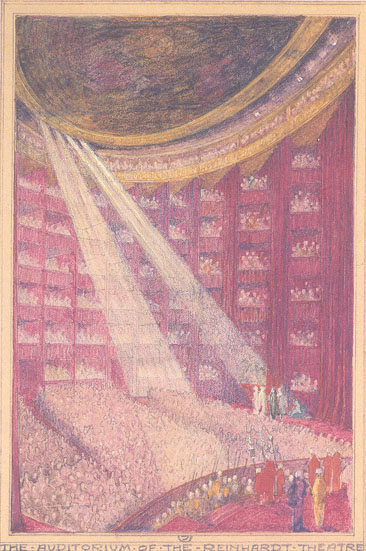
Fig. 73 Cat. 14b
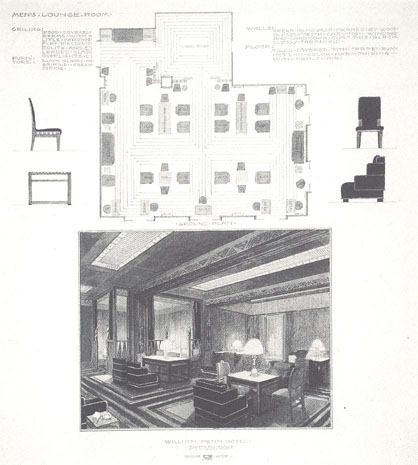
Fig. 74 Cat. 15a
62
- William Penn Hotel, Pittsburgh,
1928–29
a. Mens Lounge Room, detail and plan, watercolor, 20
x 16 7/8 in., fig. 74
b. Ballroom, watercolor, 13 3/8 x 20 in.
- Central Park Casino, New
York, 1929
a. Reconstruction, exterior, watercolor, 5 1/2 x 9
3/8 in.
b. Pavilion, photograph, 7 3/5 x 9 5/8 in.
- International Magazine Building, New
York, 1929
a. Exterior, photograph (detail; Sigurd Fischer), 9
3/4 x 7 1/2 in., fig. 1
b. Lobby, photograph, 9 5/8 x 5 1/2 in.
- Jewish Art Theatre (proposal), New
York, 1929
a. Front elevation, watercolor, 16 3/8 x 16 3/8 in.
b. Proscenium, pen and ink with wash and watercolor,
8 1/8 x 13 1/4 in., fig. 75
- The New School for Social Research, New
York, 1929–31
a. Elevation, pen and ink with watercolor, 20 1/2 x
15 in., fig. 59
b. Main lobby, color treatment, watercolor, 14 5/8
x 14 5/8 in.
c. Dance studio, color treatment, watercolor, 14 1/4
x 26 3/4 in., fig. 45
d. Library, photograph, 7 1/2 x 9 3/4 in., fig. 61
e. Auditorium, perspective, pencil, 12 5/8 x 16 1/4
in.
f. Auditorium, photograph, 10 1/4 x 13 1/4 in., fig. 60
- Atlantic Beach Club, Long
Island, terraced apartments, 1929–31
watercolor, 18 1/2 x 20 1/8 in., fig. 44
- Park Avenue Restaurant, New
York, interior of club, 1931
photograph, 15 7/8 x 19 7/8 in., fig. 76
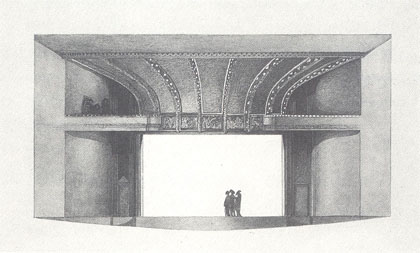
Fig. 75 Cat. 18b
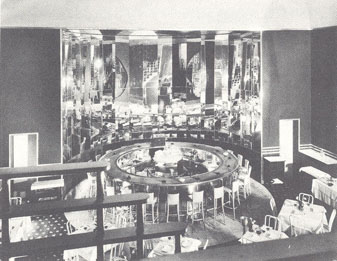
Fig. 76 Cat. 21
63
- Palace Of the Soviets, interior:
large hall with demonstration, 1931–32
watercolor, 29 3/8 x 25 in., fig. 77
- Fairytale illustration, n.d.
watercolor, 4 x 5 in., fig. 34
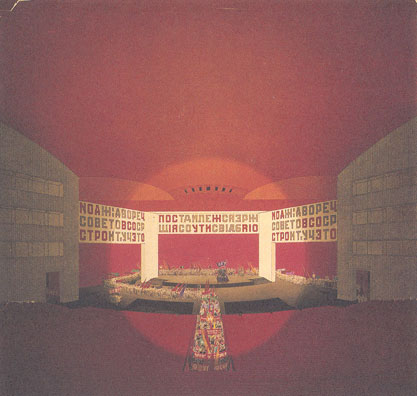
Fig. 77 Cat. 22
64
OPERA
- Die Meistersinger Von Nurnberg, act
1: Inside Saint Katherine 's Church, 1908
watercolor, 8 1/2 x 13 1/2 in., fig. 25
- Lohengrin, curtain,
1 909–11
watercolor, 10 1/4 x 9 1/2 in., fig. 43
- Oberon, act 2: Banquet
hall of Haroun al Rachid, 1909–1 1
pencil, 9 3/4 x 12 5/8 in.
- Tristan Und Isolde, sketches
of footwear, 1909–11
watercolor, 9 1/8 x 11 3/4 in.; 10 1/4 x 12 3/4 in.
- Godtterdammerung, act
3.2: Rhine woodland and valley, 1911
pencil 9 x 12 in.
- Contes d'Hoffmann, 1912
(B)
a. Act 2: Olympia, costume drawings for male guests,
watercolor, 10 3/4 x 7 1/2 in.
b. Act 4: Bacchanal: Giulietta and guests, watercolor,
8 5/8 x 9 1/2 in., fig. 4
- Louise, act 3: A
little garden in Montmartre, 1912 (B)
watercolor, 6 x 12 1/8 in., fig. 19
- Madama Butterfly, act
2: Inside Butterfly's house, 1912 (B)
watercolor, 8 3/4 x 9 in., fig. 31
- Djamileh, elevation
and ground plan, Haroun's palace, 1913 (B)
watercolor, 11 1/4 x 8 5/8 in., fig. 33
- Don Giovanni, act
1.4: Giovanni's garden, 1913 (B)
watercolor, 7 x 9 3/4 in., fig. 23
- Die Meistersinser von Nurnberg, act
3.5: Open meadow, costume drawing, 1914 (B)
watercolor, 6 7/8 x 10 3/8 in.
- Otello, act 2: Desdemona's
garden, 1914 (B)
watercolor, 9 1/2 x 11 1/2 Vi in., fig. 35
- Parsifal, act 2:
Klingsor's magic castle, 1914 (B)
watercolor, 4 1/8 x 3 7/8 in., fig. 26
- Faust, 1917(M)
a. Act 2: Fairgrounds at the town gates, watercolor,
9 1/4 x 13 1/8 in.
b. Act 5.1: Walpurgisnacht, watercolor, 8 3/4 x 14
in., fig. 78
- Oberon, act 1: Rezia's
sleeping garden, 1918 (M)
watercolor, 9 1/2 x 13 3/4 in., fig. 79
- Saint Elizabeth, act
5: woods, 1918 (M)
watercolor, 9 1/4 x 13 3/4 in., fig. 29
- Don Carlos, 1920
(M)
a. Act 1: Forest at Fontainebleau,
watercolor, 8 3/4 x 12 in., fig. 80
b Act. 3.2: Square in front of Valladolid Cathedral,
watercolor, 6 5/8 x 9 1/8in., fig. 29
- Parsifal, 1920(M)
a. Act 1.1: Sacred grove,
watercolor, 12 x 17 5/8 in., fig. 27
b. b. Act 2.2: Klingsor's garden (unused),
watercolor, 7 x 12 in., fig. 36
65
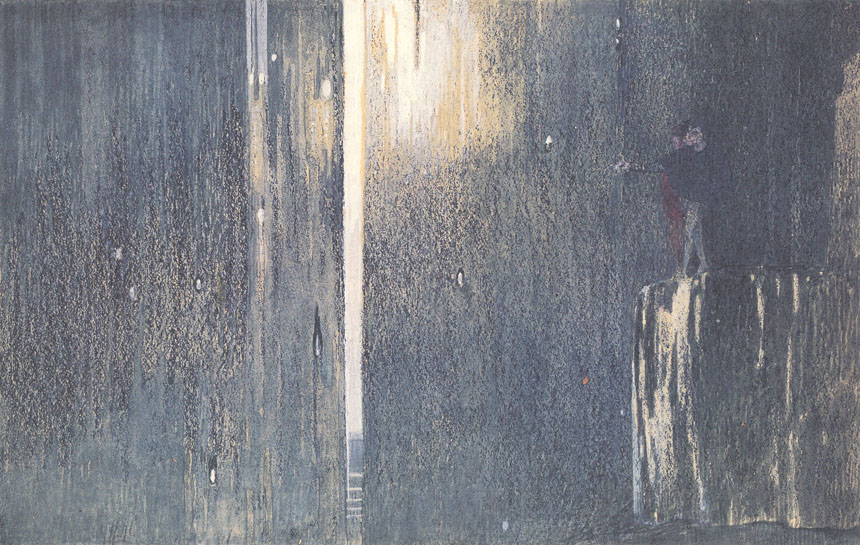
Fig. 78 Cat. 37b
66
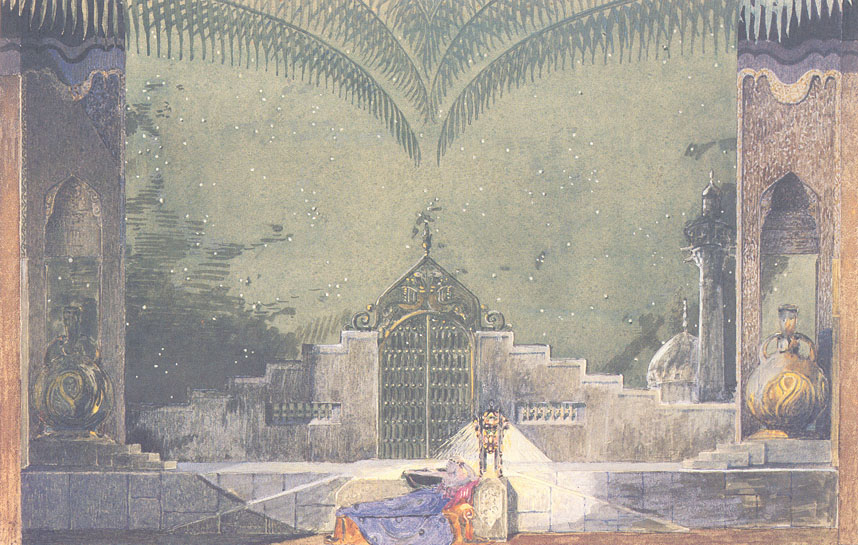
Fig. 79 Cat. 38
67
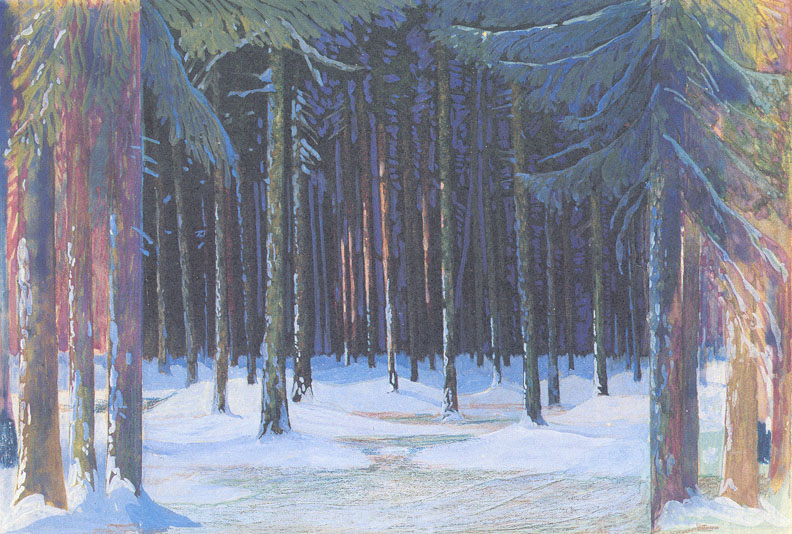
Fig. 80 Cat. 40a
68
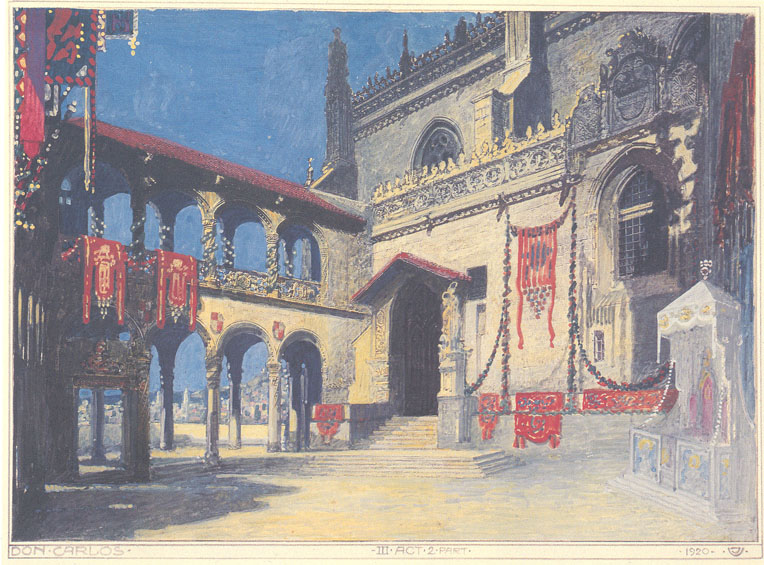
Fig. 81 Cat. 40b
69
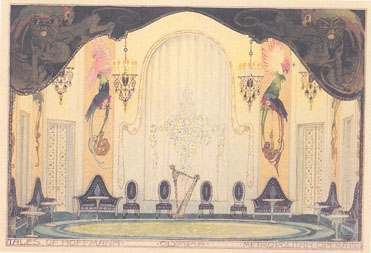
Fig. 82 Cat. 42
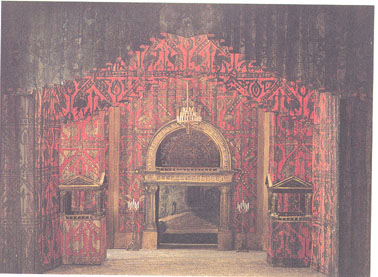
Fig. 83 Cat. 43a
- Contes d'Hoffmann, act
2.2: Olympia, ballroom, 1924 (M)
watercolor, 10 1/2 x 13 1/2 in., fig. 52
- Don Giovanni, 1929(M)
a. Act 1.5: Ballroom, set model: painted cardboard
and other materials, 13 1/2 x 21 x 26 in., fig. 83
b. Act 2.5: Giovanni's dining room, watercolor, 9 7/8
x 9 1/8 in., fig. 84
- Jonny spielt auf, act
2.5: Train station, 1929 (M)
set model: painted cardboard and other materials, 23
x 25 7/8 x 19 1/8 in., fig. 21
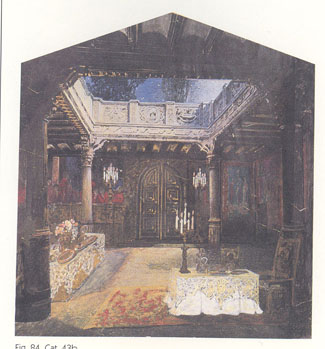
Fig. 84 Cat. 43b
70
- Schwanda, der Dudelsakpfeifer, act
2.2: Entrance to city, 1931 (M)
watercolor, 11 3/8 x 15 1/4 in., fig. 20
- Die Walkure, a rocky
mountain ridge, n.d.
pencil, 8 3/8 x 10 1/2in.
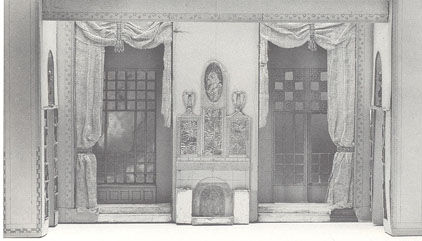
Fig. 85 Cat. 48b
THEATER
- The Garden of Paradise, queen's
bower, 1914
watercolor, 9 x 14 in., fig. 37
- Behold Thy Wife, 1915
a. Act 3: Library, watercolor, 9 1/8 x 14 in.
b. Act 3: Library, set model: painted cardboard and
other materials, 13 x 18 1/4 x 7l/2 in.,fig. 85
- The Ziegfeld Follies of
1915 (Z)
a. Flower curtain, watercolor, 8 1/4 x 13 1/8 in.
b. Zeppelin over London, watercolor, 8 x 13 in., fig. 48
c. Bath scene with golden elephants, photograph, 5
3/4 x 8 1/2 in., fig. 47
- Caliban of the Yellow Sands, 1916
a. Ground plan for auditorium and stage, watercolor,
32 x 23 in.
b. Setebos, watercolor, 17 x 13 3/4 in., fig. 86
- The Century Girl, bubbles,
1916 (z) watercolor, 9 1/2 x 13 5/8 in., fig. 87
- The Ziegfeld Follies of
1916 (Z)
a. Globe Theater curtain, watercolor, 8 1/2 x 12 1/4
in.
b. Opening scene, watercolor, 9 1/4 x 14 in., fig. 88
- Macbeth, outside
the castle, 1916
watercolor, 9 3/8 x 14 in., fig. 49
- The Ziegfeld Follies of
1917 (Z)
a. Contract letter dated 7 February 1917, typescript,
10 1/2 x 7 1/4 in.
b. Running order, typescript, 15 x 8 1/4 in.
71
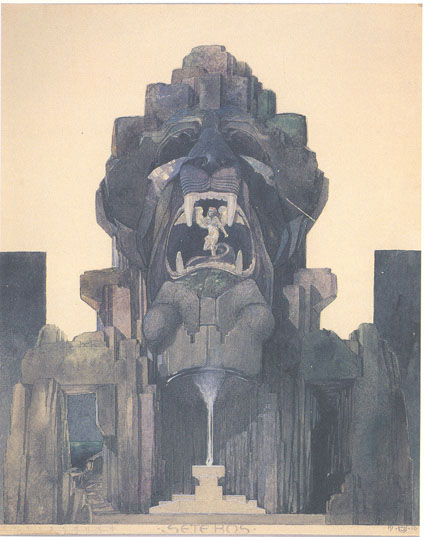
Fig. 86 Cat. 50b
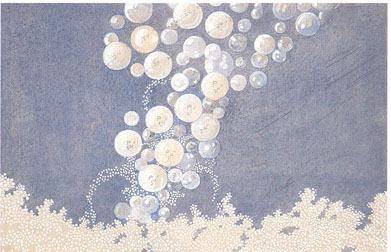
Fig. 87 Cat. 51
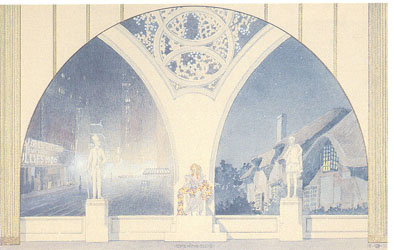
Fig. 88 Cat. 52b
72
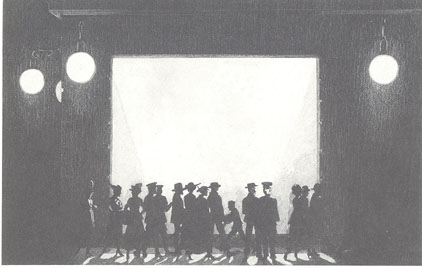
Fig. 89 Cat. 58a
- The Ziegfeld Follies of
1918, the Blue Devils (Z) watercolor,
8 7/8 x 12 7/8 in.
- Apple Blossoms, act
3: Color scheme for fancy interior, 1919
watercolor, 10 x 10 7/8 in., fig. 7
- Caesar's Wife, check
stub, 1919(Z)
ink on paper, 4 1/2 x 8 3/4 in.
- Young Man's Fancy, 1919
a. New York street scene at night, watercolor, 9 3/4
x 13 3/4 in., fig. 89
b. Store window, photograph, with Urban's annotations,
11 x 14 in.
- The Ziegfeld Follies Of 1921, Venetian
cityscape (Z)
watercolor, 10 1/8 x 12 in., fig. 90
- No Foolin'. 1922(X)
a. Skyscraper, watercolor, 10 1/4 x 12 1/4 in., fig. 91
b. Curtain (unused), watercolor, 10 1/4 x 12 1/2 in.
- The Ziegfeld Follies of
1923 (Z)
a. Act 1: Finale, technical drawings, mixed materials,
9 5/8 x 13 3/4 in.
b. Exterior of a Spanish house, watercolor, 10 1/8
x 12 1/8 in., fig. 92
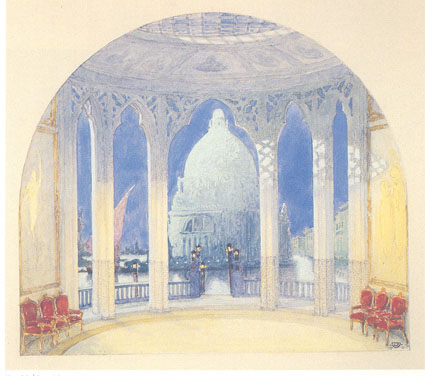
Fig. 90 Cat. 59
73
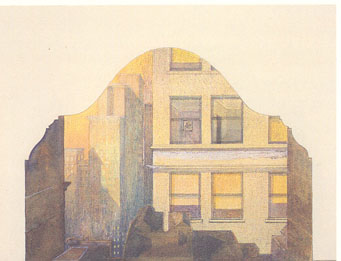
Fig. 91 Cat. 60a
- Orpheum Circuit, oriental
city backdrop, 1925
watercolor, 10 x 13 1/8 in., frontispiece
- Palm Beach Girl, 1926
(z)
a. Snowbound (unused), watercolor, 10 1/2 x 13 1/2
in.
b. Palm Beach Nights curtain, watercolor, 5 1/8 x 7
1/2 in., fig. 93
- Golden Dawn, straw
curtain, 1927
watercolor, 8 1/2 x 8 5/8 in.
- Rio Rita, 1927 (z)
a. Barge floating on the Rio Grande, watercolor, 10
1/8 x 12 1/4 in.
b. Courtyard of a Mexican mansion, watercolor, 8 1/4
x 9 1/2 in., fig. 94
c. Courtyard of a Mexican mansion, set model: painted
cardboard and other materials, 153/4 x 19'/8 x 13'/4
in., fig. 95
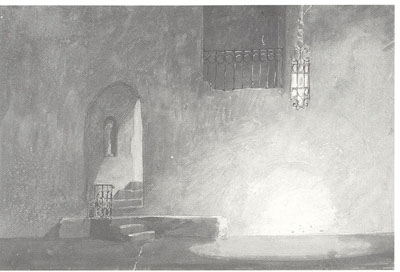
Fig. 92 Cat. 61b
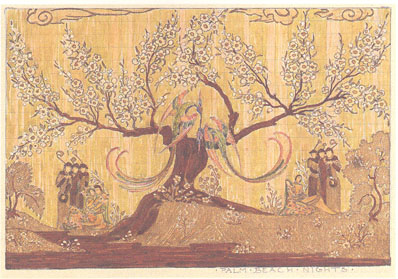
Fig. 93 Cat. 63b
74
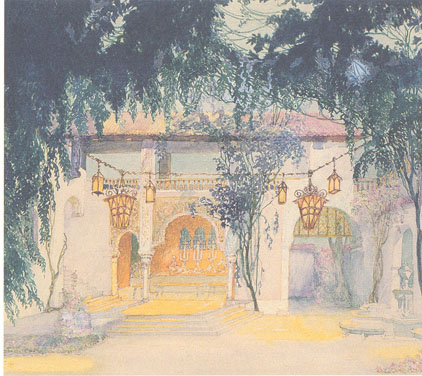
Fig. 94 Cat. 65b
- The Ziegfeld Follies Of
1927, castles in the clouds (Z)
watercolor, 13 1/2 x 15 7/8 in.
- Whoopee, adobe mission,
1928(Z)
set model: painted cardboard and other materials, 18
1/8 x 20 1/2 x 15 1/8 in., fig. 96
- Sons O' Guns, act
2.8: Ballroom, 1929
set model: painted cardboard and other materials, 17
x 19 7/8 x 11 in., fig. 97
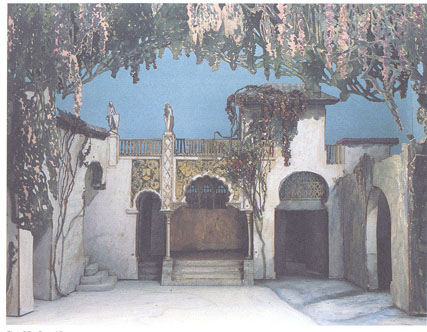
Fig. 95 Cat. 65c
75
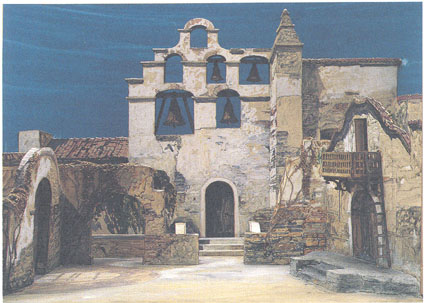
Fig. 96 Cat. 67
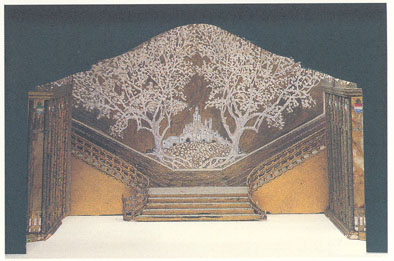
Fig. 97 Cat. 68
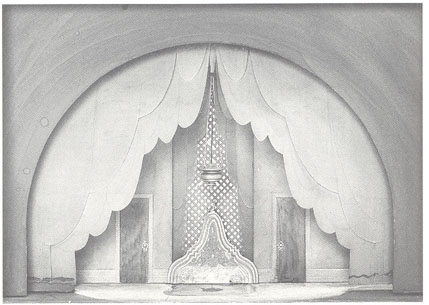
Fig. 98 Cat. 70
76
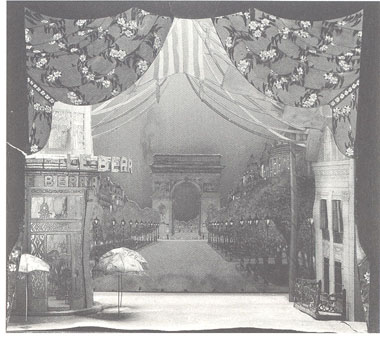
Fig. 99 Cat. 71
- Flying High, act
2.6: Flight, 1930
set model: painted cardboard and other materials, 15
1/8 x 22 1/4 x 11 3/4 in., fig. 22
- Princess Charming, bedroom,
1930
set model: painted cardboard and other materials, 16
1/8 x 18 7/8 x 5 3/8 in., fig. 98
- Smiles, Cafe le
Berry, 1930 (Z)
set model: painted cardboard and other materials, 22
7/8 x 22 1/4 x 15 3/4 in., fig. 99
77
FILM
- Rivoli Theatre, stage
setting, 1919
watercolor, 15 3/8 x 15 7/8 in.
- Enchantment, stairway
of Hoyt house, 1921
photograph, 7 1/2 x 9 1/4 in.
- The Woman God Changed, 1921
a. Courtroom, watercolor, 14 3/8 x 20 in.
b. Set of courtroom scene, photograph, 5 5/8 x 9 3/4
in.
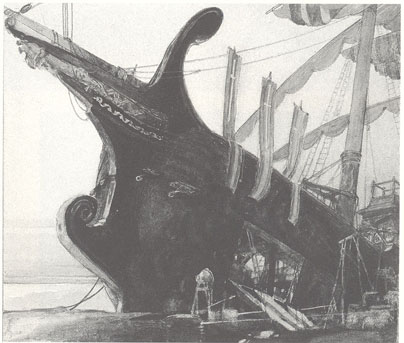
Fig. 100 Cat. 76
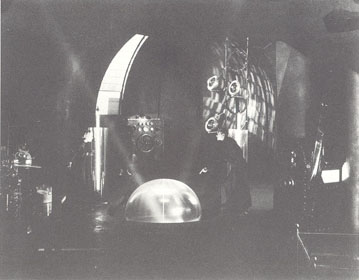
Fig. 101 Cat. 77a
- Bride's Play, wedding
scene, 1922
photograph, 7 3/4 x 93/4 in.
- Buried Treasure, pirate
ship scene, 1922
watercolor, 10 1/8 x 11 1/2 in., fig. 100
- The Young Diana, 1922
a. Dimitrius' laboratory, photograph, 7 3/4 x 9 3/4
in., fig. 101
b. Dimitrius' study, photograph, 7 3/8 x 91/2 in., fig. 68
- Under the Red Robe, 1923
a. Cardinal Richelieu's reception room, photograph,
7 1/4 x 9 1/2 in.
b. Louis XIII's reception room, photograph, 7 1/4 x
9 1/2 in.
78
PHOTOGRAPH CREDITS
All photographs,
identified by figure number, are by
Dwight Primiano Photography, with the following exceptions:
Cosmopolitan Productions 62-68, 101
Sigurd Fischer 1, 16
F. E. Geisler 3, 56
Gerlach and Schenk 9, 10
Peter A. Juley 13
Nyholm–Lincoln 60, 61, 76
unidentified 1, 2, 14, 47, 53, 54, 69, 70
79
|


































































































